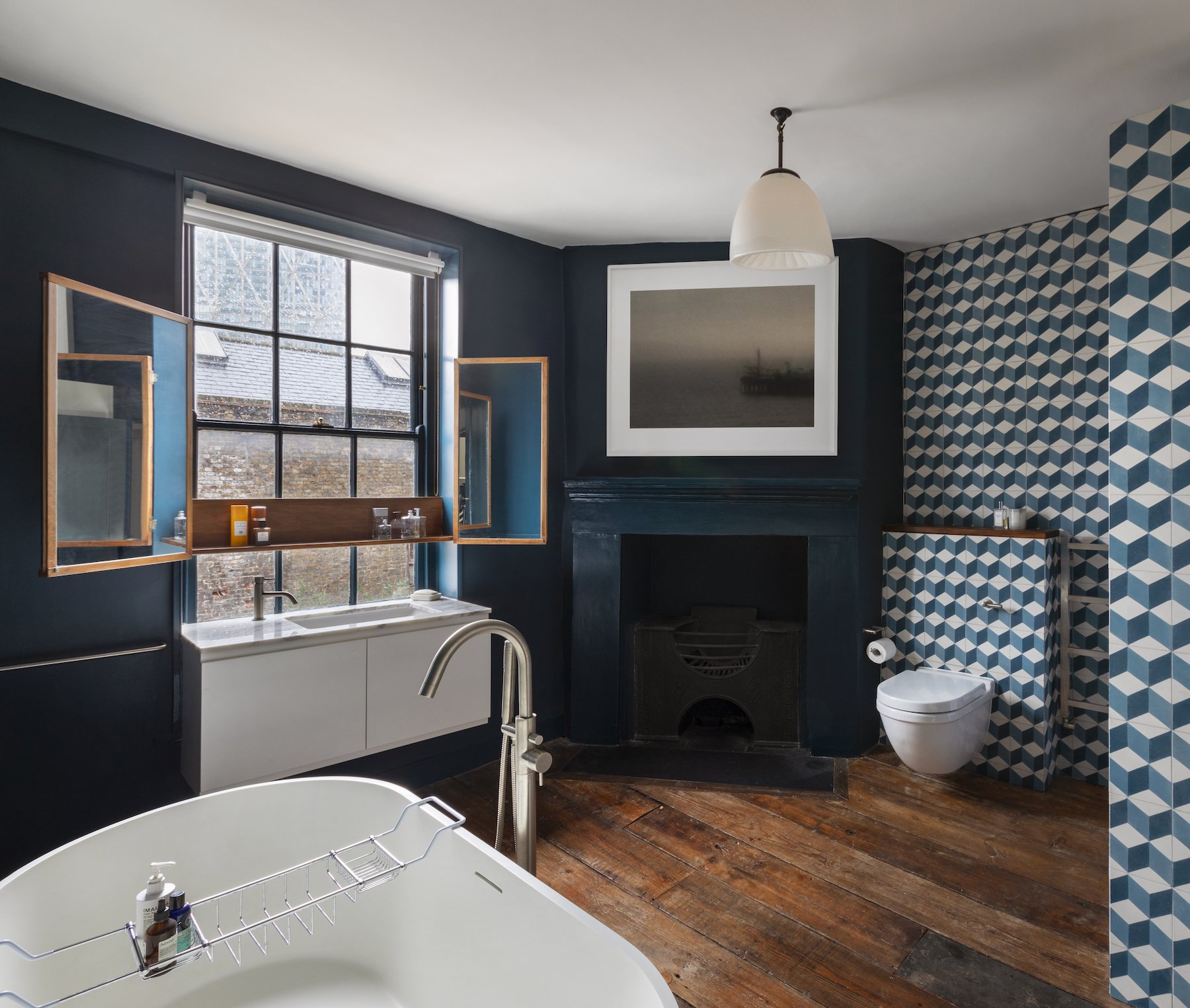
Our Reclaimed Wood
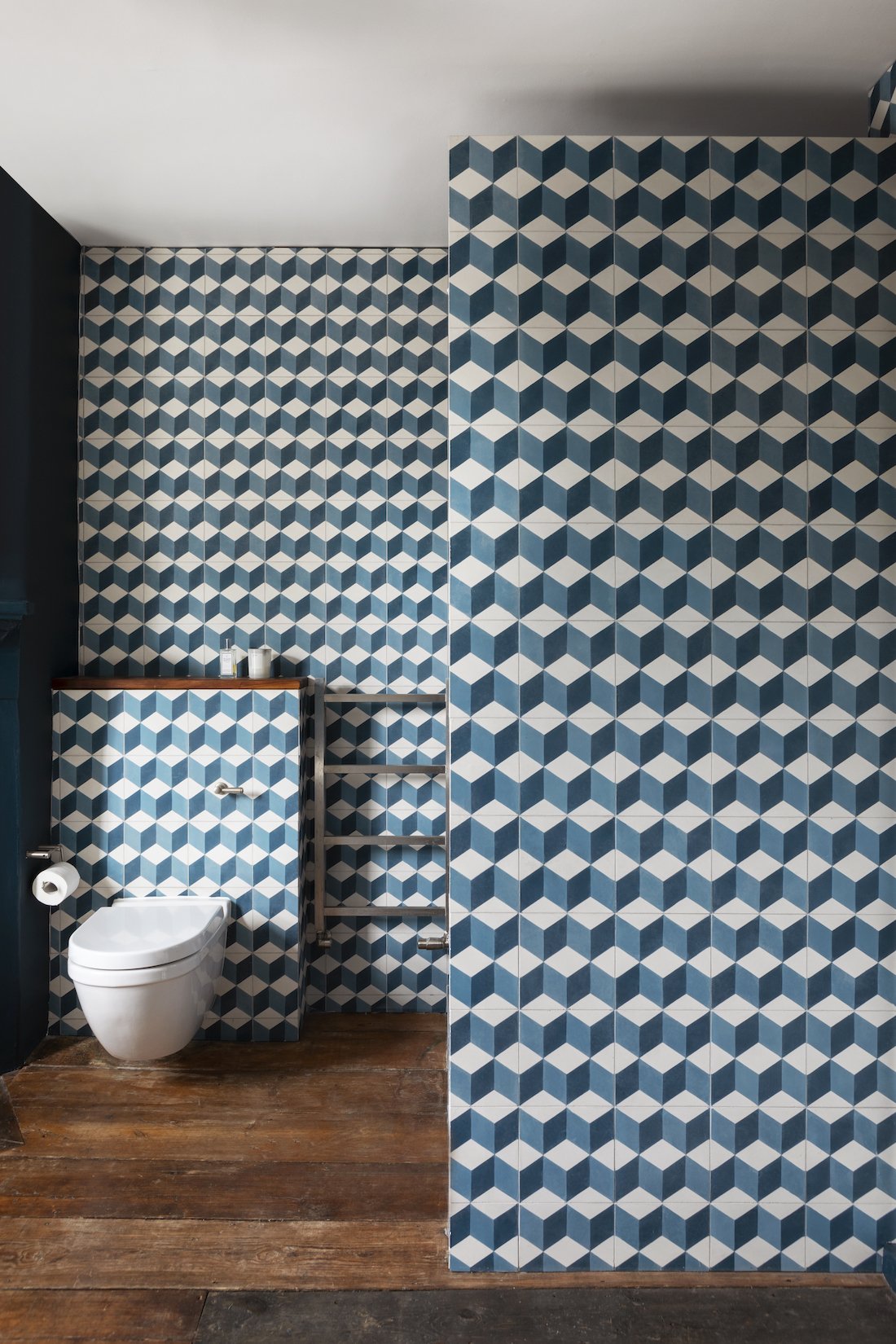
Our Reclaimed Wood
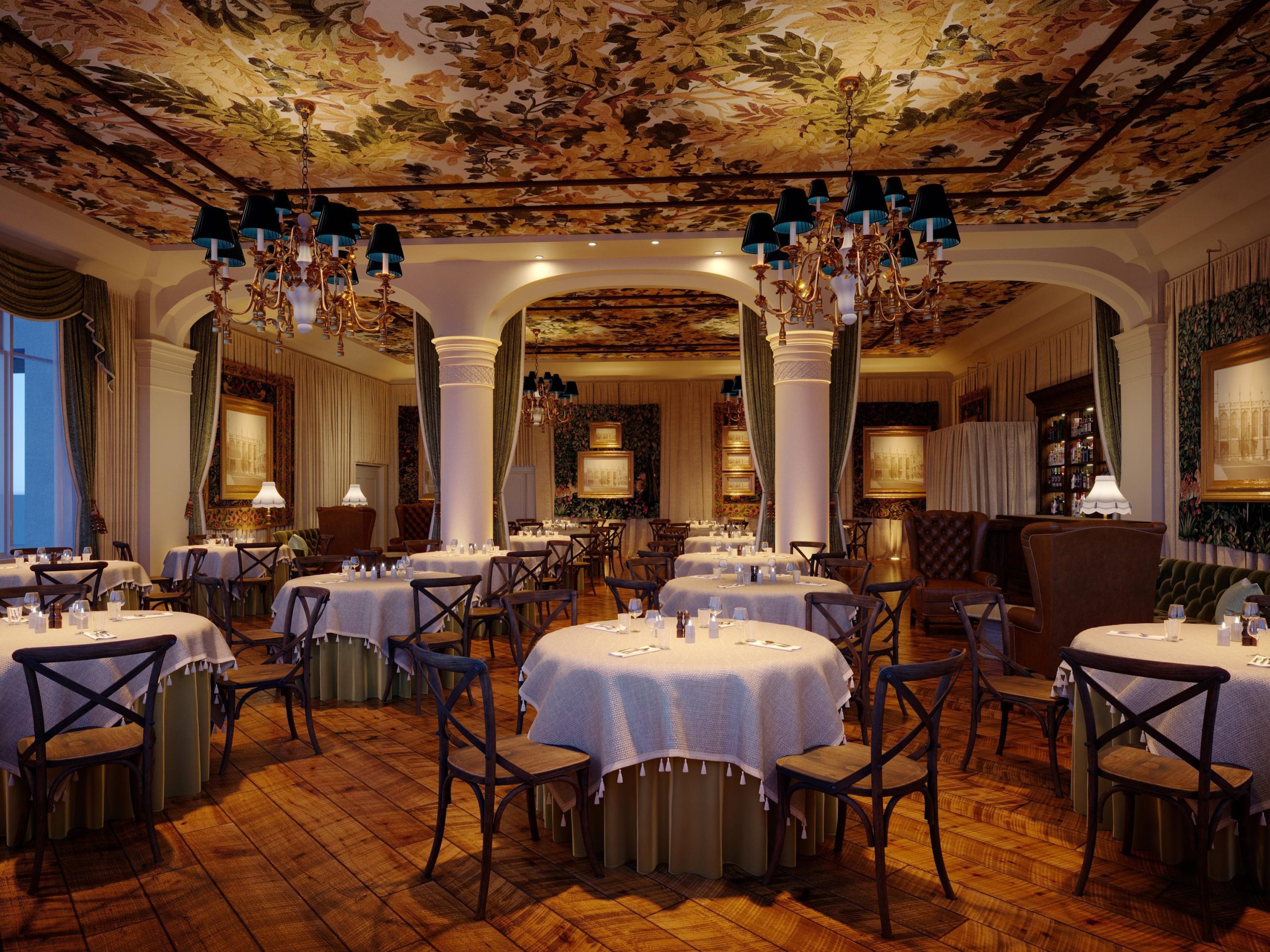
“Step with care and great tact, and remember that life’s a great balancing act.” — Dr. Seuss
Venture into the grand halls of the Victoria and Albert Museum in London, and you’re enveloped by an aura of artistic majesty—not just from the artefacts displayed but from the very ground beneath your feet. Here, European oak flooring lays the foundation, exuding a richness and warmth that syncs perfectly with the grandeur surrounding it. Each plank tells a story, and each grain sings a song of timeless craftsmanship, offering more than just aesthetics but a tactile history that resonates with every step.
This isn’t a luxury reserved for galleries and museums; this same timeless elegance can grace your home or office, transforming everyday spaces into bastions of sophistication.
Often considered the “little black dress” of interior design, European oak flooring offers unmatched versatility and style. Whether your home whispers modern minimalism or echoes a rustic charm, European oak adapts effortlessly, enhancing any decor. It remains a perennial favourite in the fluctuating tides of interior design trends, reflecting Arianna Huffington’s view that “life is a dance between making it happen and letting it happen.”
Each plank of European oak is a masterpiece, displaying unique patterns and shades—from honeyed tones to deep, earthy browns. This diversity ensures no two floors are identical, each bringing its character and warmth to the spaces it inhabits.
European oak isn’t just about good looks; it’s built to last. Known for its durability, it stands up to the daily wear and tear of busy life—children, pets, and all. It’s a flooring choice that combines beauty with resilience, echoing Huffington’s principle that “we need to accept that we won’t always make the right decisions, but understanding that failure is not the opposite of success—it’s part of success.”
As Tim McKeough insightfully puts it, “The floor is the base upon which all other decorating decisions are built. Change your floors, and you change the character of your home.” Choosing between engineered and solid oak flooring hinges on several factors:
When integrating European oak flooring into your home, consider the following:
European oak wood flooring embodies a blend of timeless elegance and robust functionality. Whether you prefer the engineered variety for its practicality or the solid type for its enduring charm, European oak offers a foundation that supports and enhances every aspect of your living space.
Immerse your home in the enduring beauty of European oak and step into a world where every plank tells a story. With European oak, every room becomes a canvas for history and artistry, transforming your living space into a place of beauty and character.
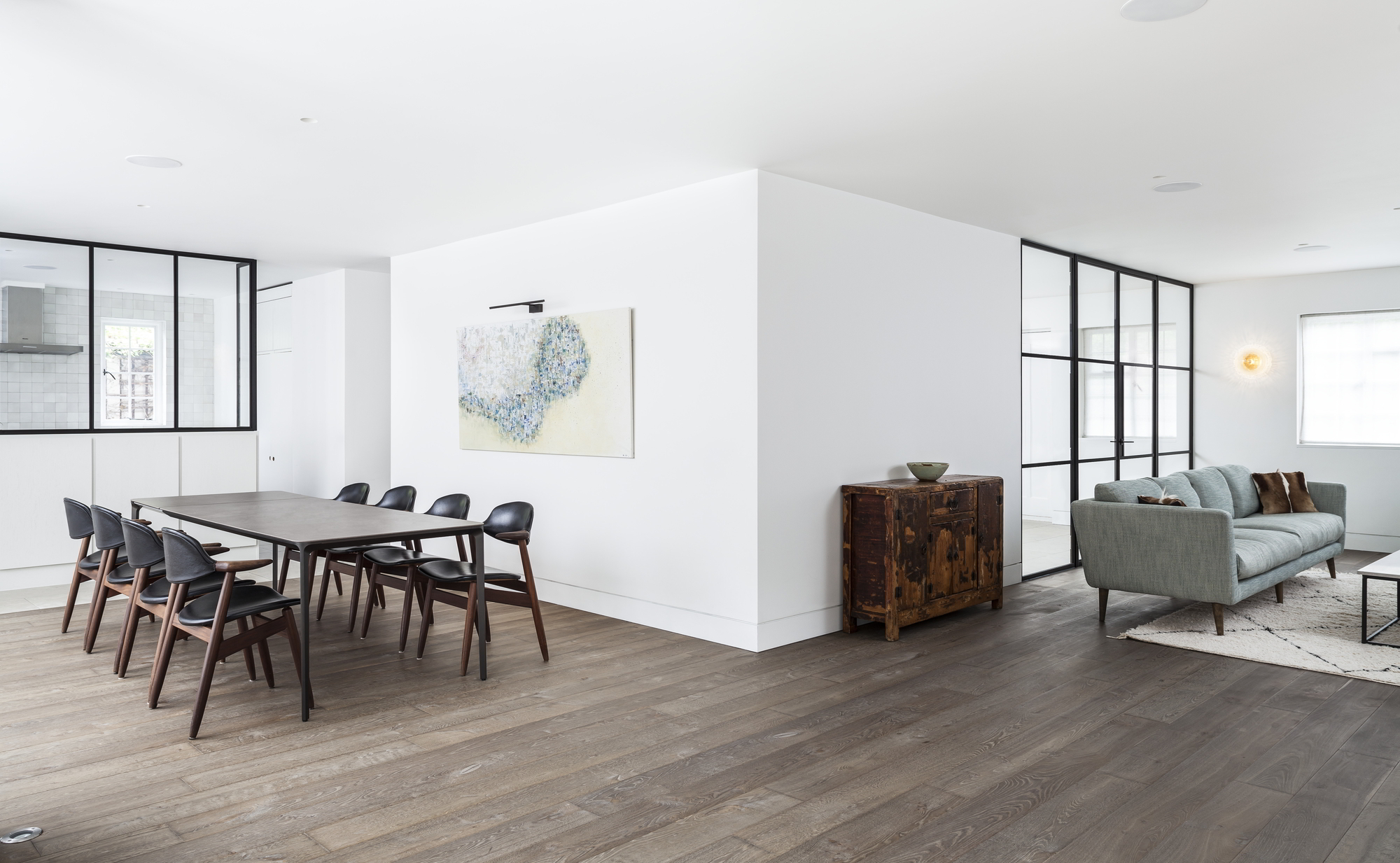
“The oak sleeps in the acorn. The bird waits in the egg, and in the highest vision of the soul, a waking angel stirs. Dreams are the seedlings of realities.” — James Allen.

Our Reclaimed Wood

Our Reclaimed Wood
When envisioning the perfect flooring for your sanctuary, oak stands as a pillar of elegance and resilience. Its natural beauty, rich tones, and pronounced grain patterns offer a foundation of undeniable charm and durability. As Arianna Huffington once noted about the enduring nature of beauty, “We need to accept that we won’t always make the right decisions, that we’ll screw up royally sometimes – understanding that failure is not the opposite of success, it’s part of success.”
Reclaimed oak flooring is like a canvas painted with the brushstrokes of history—each plank a relic of past epochs, each grain a testament to resilience and time’s artistry. Imagine floors that once underpinned an old Victorian warehouse, their surfaces bearing the tales of years past with every knot and nail hole. This is the allure of reclaimed oak: it offers a warmth and character that new oak cannot parallel, embodying what Huffington describes as “perfect imperfections.”
Conversely, new oak flooring offers a pristine beginning. It is uniform in colour and texture and caters to those who cherish sleekness and modernity. This option paints a portrait of sophistication and elegance, ideal for contemporary interiors.
The sustainability of reclaimed oak flooring is unparalleled. At the heart of its philosophy is the reclamation and restoration of wood, a practice that significantly diminishes the demand for freshly cut timber. This conserves our precious forests and reduces waste, echoing Huffington’s advocacy for a life that respects our environmental limits.
In contrast, while new oak requires the harvest of fresh timber, many modern providers adhere to sustainable forestry practices. These efforts help minimize the environmental footprint, allowing the beauty of new oak to be enjoyed with a clearer conscience. The reclaimed and the new oak offer advantages that cater to the ecologically conscious, yet reclaimed wood stands out for its more profound commitment to environmental stewardship.
Reclaimed oak floors boast extraordinary durability, having stood the test of time and elements. Their rich history adds depth to your home’s decor and aligns with eco-friendly values by repurposing what would otherwise be discarded. Remodelista points out that this makes reclaimed oak an excellent choice for those looking to reduce their ecological footprint.
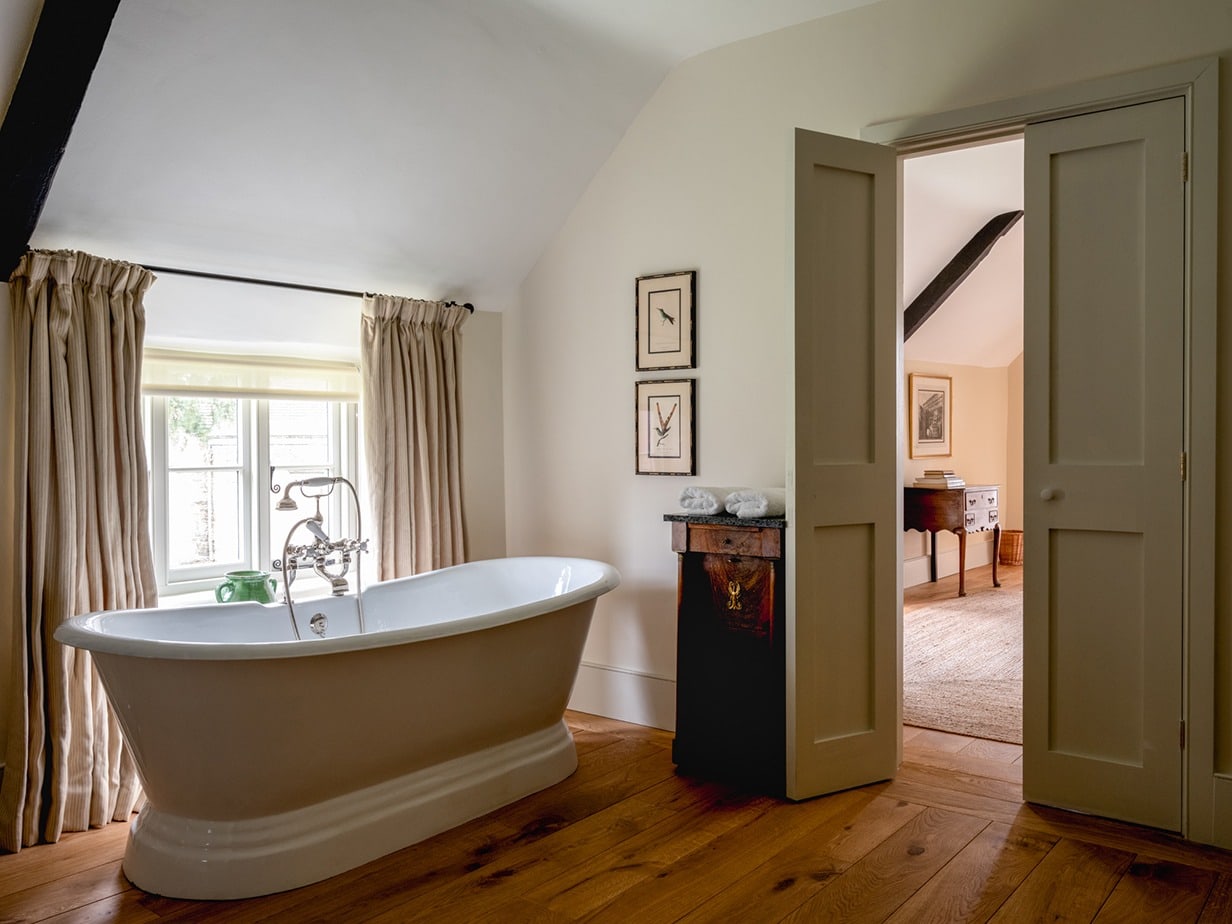
Our New Wood

Our New Wood
New oak is also durable, especially with modern treatments, but it lacks the historical narrative that reclaimed wood carries. However, it benefits from contemporary processing technologies that enhance its natural resilience, promising longevity.
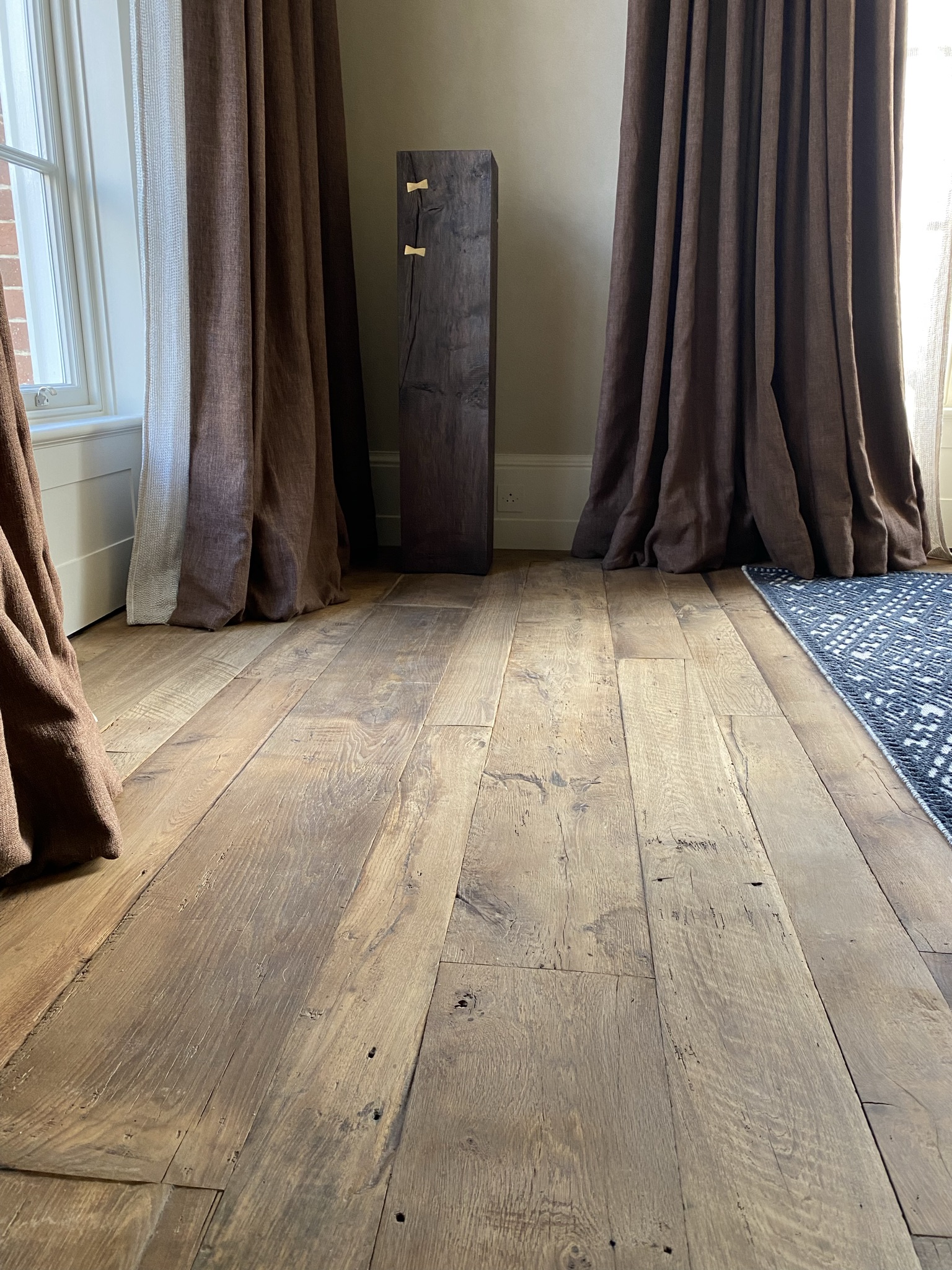
Our Reclaimed Wood
Cost is a significant factor in deciding between reclaimed and new oak flooring. Reclaimed oak demands meticulous preparation—salvaging, cleaning, and crafting each piece to preserve its unique historical character. This adds to its charm and cost, making it a premium choice, as noted by Remodelista.
Alternatively, new oak is generally more cost-effective. Managed forest resources and efficient production processes make new oak more accessible and uniform, appealing for budget-conscious renovations.
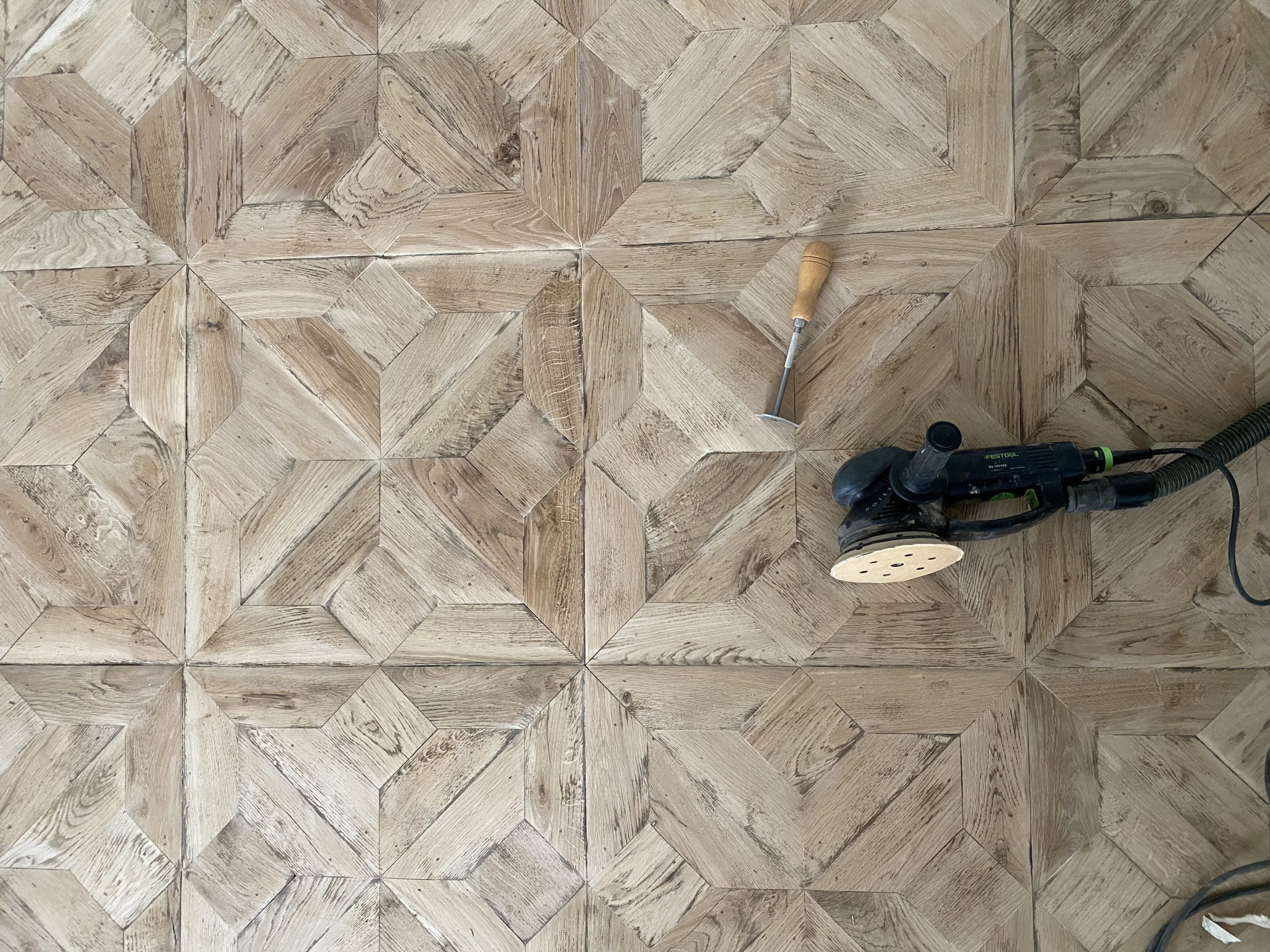
Our Reclaimed Wood
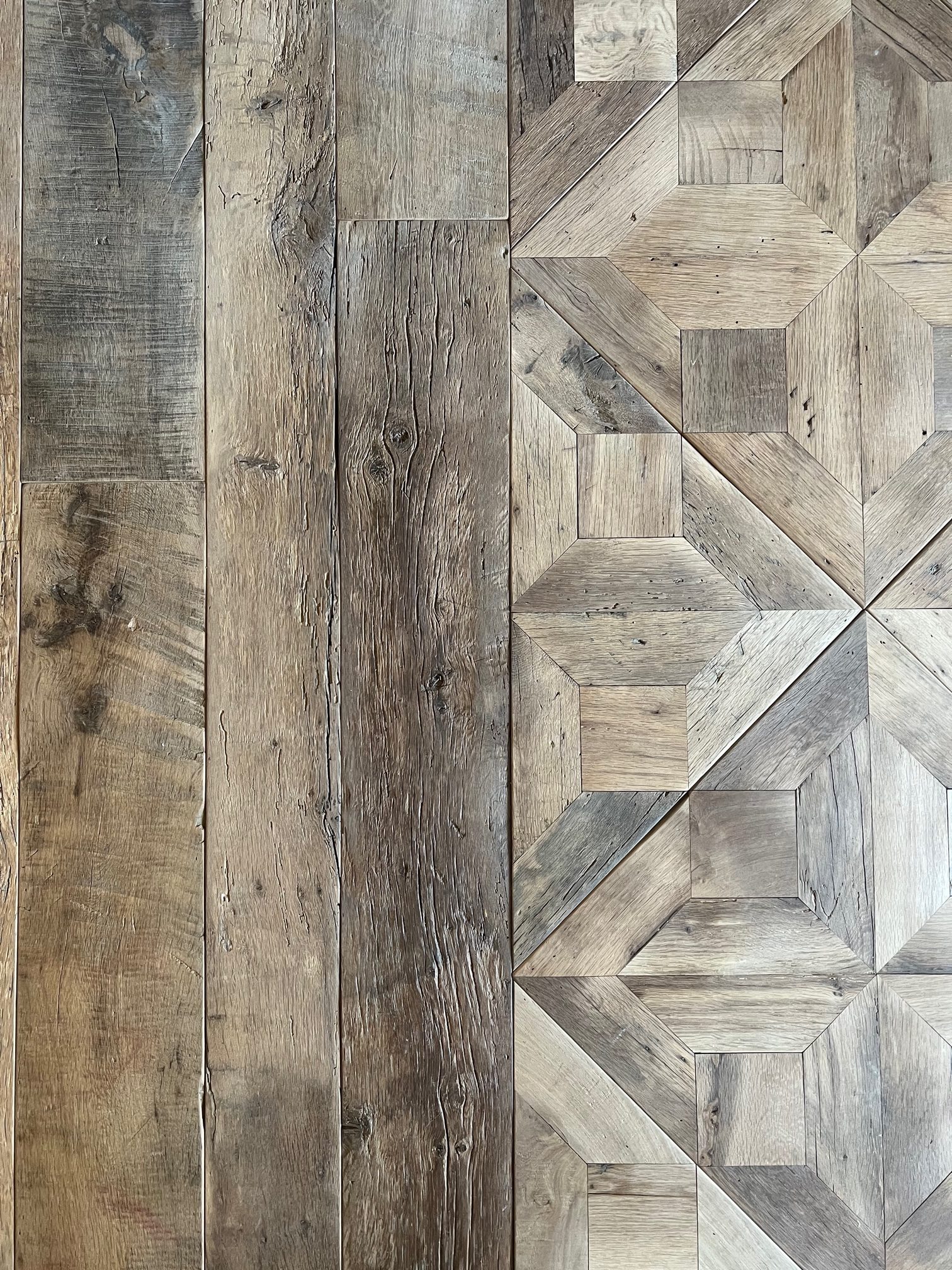
Our Reclaimed Wood

Our Reclaimed Wood
The installation of reclaimed oak flooring is an art form, requiring skilled craftsmanship to ensure each unique plank fits seamlessly into its new role. This labour-intensive process underscores the wood’s storied past and inherent beauty.
New oak, with its consistent size and texture, offers a straightforward installation process. The availability of prefinished options further streamlines the transformation of living spaces, eliminating the need for on-site finishing and providing a quick and convenient solution.
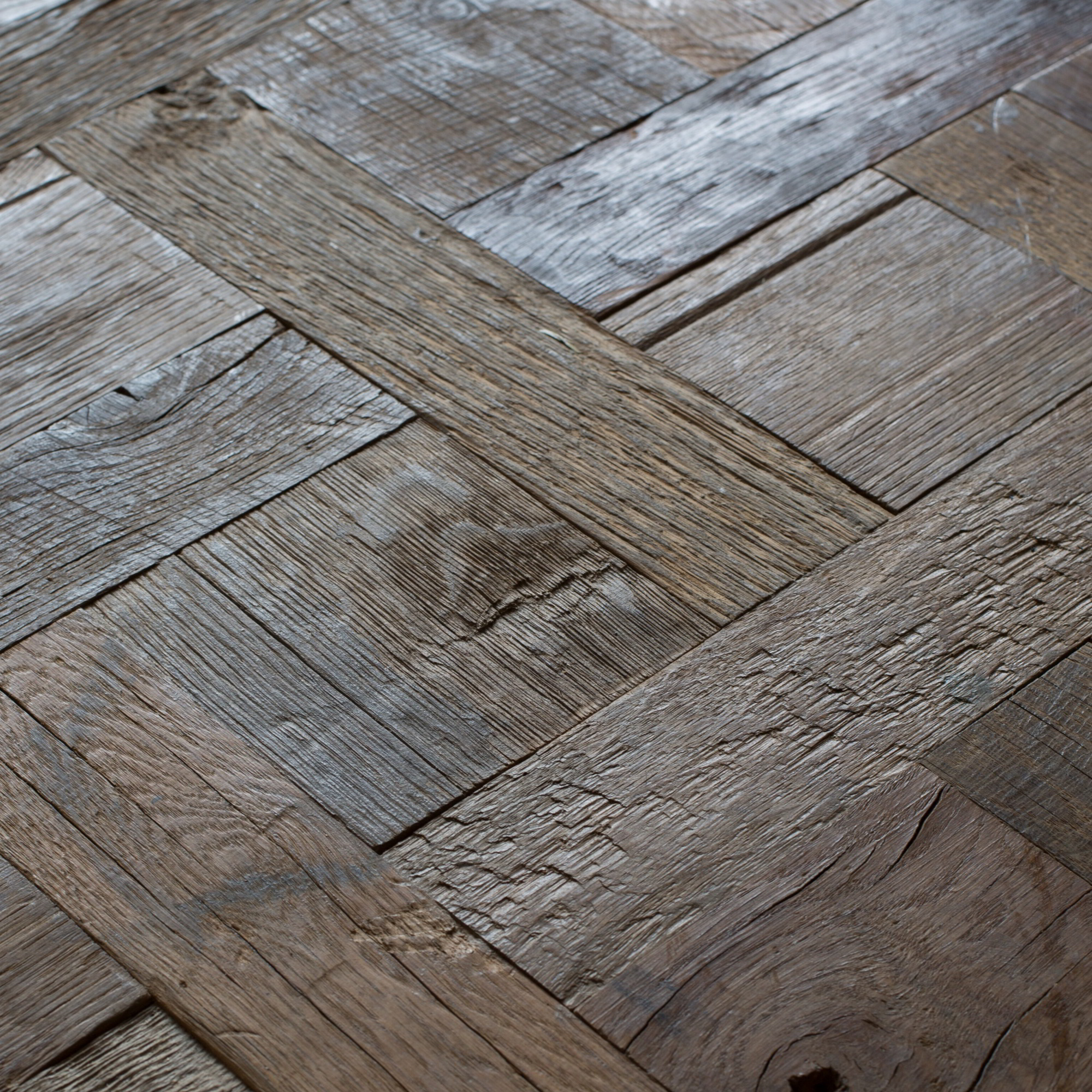
Our Reclaimed Wood
Choosing between reclaimed and new oak flooring is more than a practical decision—it reflects personal values and aesthetic vision. Whether you resonate with the rich narrative of reclaimed wood or new oak’s sleek, modern appeal, both paths offer a foundation of beauty and durability.
As you contemplate your choice, consider Arianna Huffington’s words: “We think, mistakenly, that success is the result of the amount of time we put in at work, instead of the quality of time we put in.” This philosophy can guide your decision, focusing on the quality and story that each option brings to your life and home, ensuring your choice meets your practical needs and aligns with your deeper values.
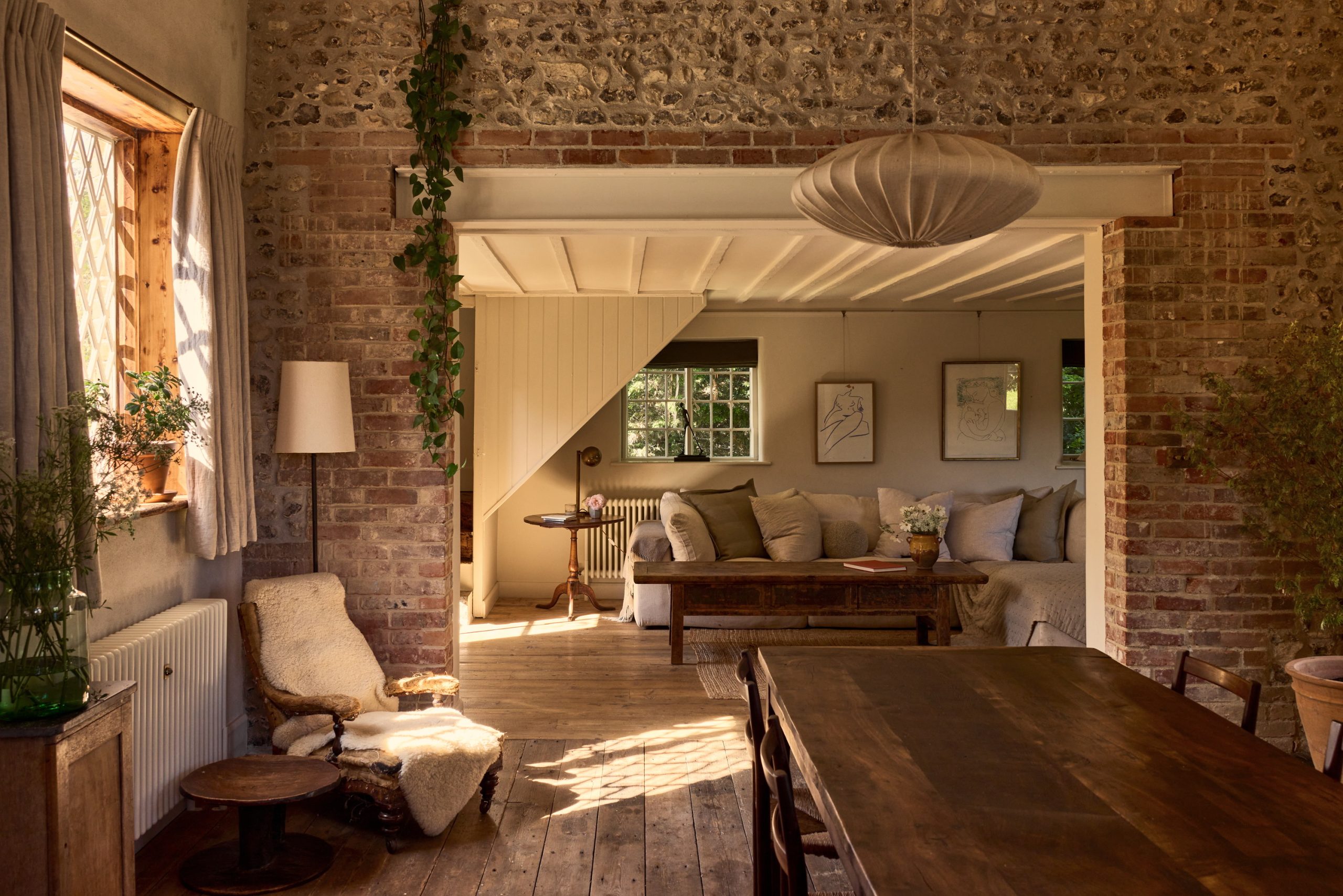
Our Reclaimed Wood

Imagine yourself in a serene forest clearing, where the sun streams through the leaves, casting a warm glow on the tall tree trunks.

As you study the intricate patterns in the wood, you notice the dance of light and shadow. Running your fingers along the grooves, you can almost hear the whispers of winds that have blown through the decades. Every knot, curve, and bulge speaks of the tree’s journey – the storms it weathered and the elements it faced.
Then, your eyes are drawn to the rich colours, hues shifting subtly like brushstrokes on an artist’s canvas.
The warm amber tones evoke lazy summer sunsets, while the cool greys and browns echo the autumn rains.
This kaleidoscope of colours is nature’s artwork, evolving with the changing seasons. But beyond the natural interplay of colours and sunlight lies something strong yet resilient, powerful yet humble: the tree itself.


Hidden beneath the rough bark of every tree trunk is an inner beauty, a living spirit shaped over many years. This inner essence, the very “soul” of the tree, is nature’s magnificent tapestry. For George Nakashima, the world-renowned woodworker and artist, uncovering and expressing this essence was the ultimate goal of the craft.
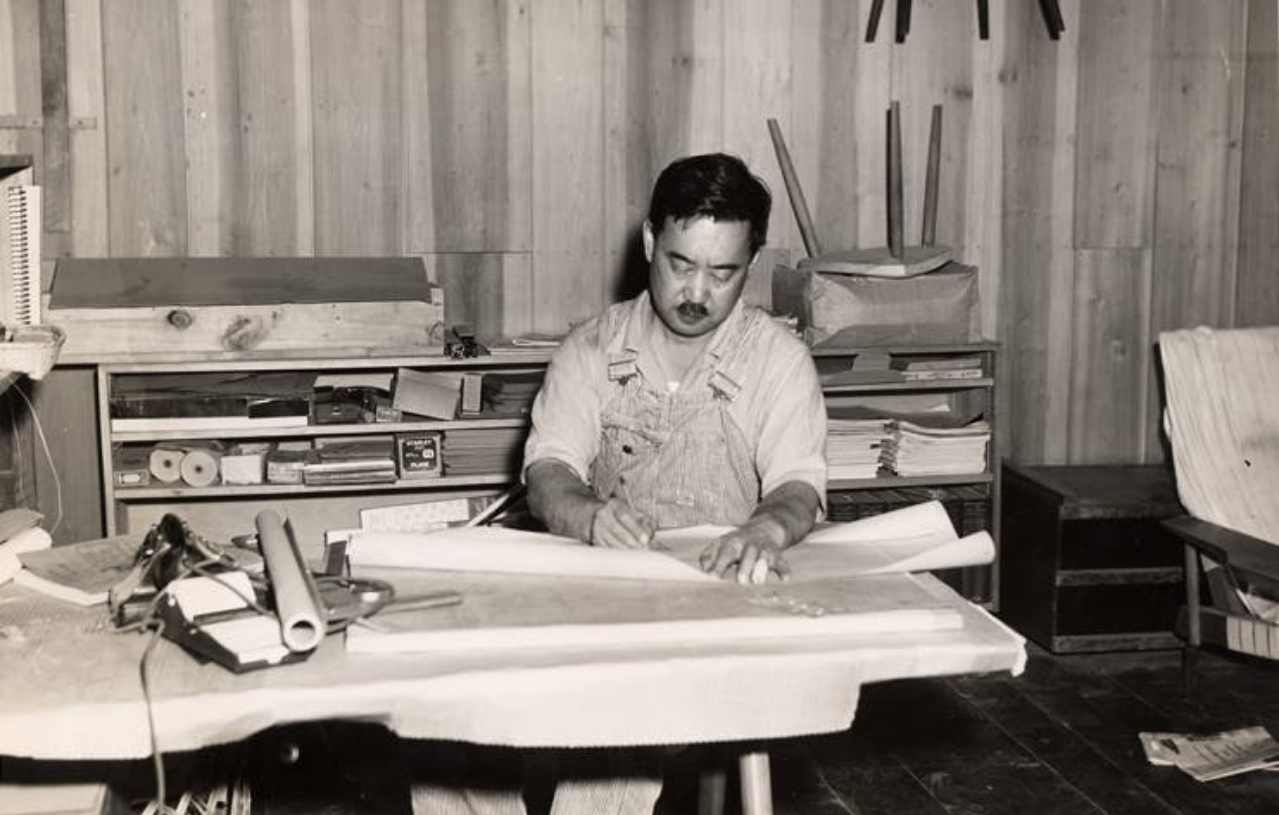
In The Soul of a Tree, Nakashima writes, “Each flitch, each board, each plank can have only one ideal use. The woodworker, applying a thousand skills, must find that ideal use and then shape the wood to realize its true potential.” (Nakashima, 1997)
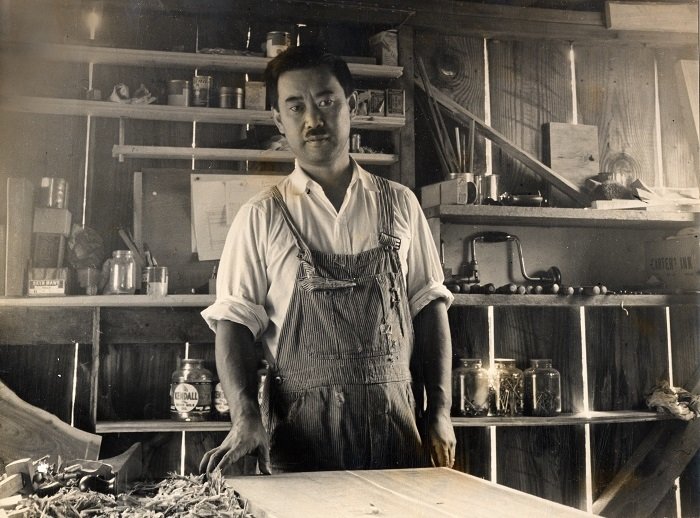
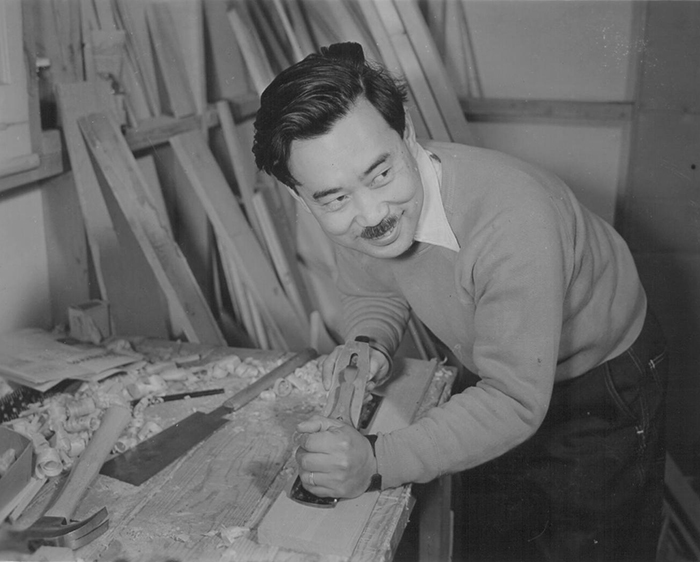

To most, a piece of timber seems simple – bark and grains.
But for those who understand wood’s essence, these distinctive “flaws” are its beauty.
Nakashima carefully studied and celebrated these imperfections, realizing that “The created object can live forever. The tree lives on in its new form.” He saw wood as a living material, constantly reacting to its environment.
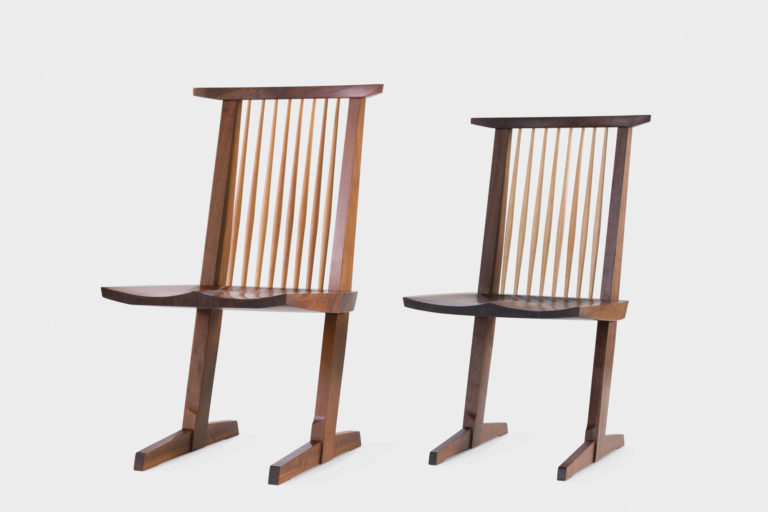
Knots, burls, and irregular patterns express each tree’s resilience journey, born from enduring harsh winds, recovering from injuries, and standing firm through changing seasons. Concealing these markings would erase the living record of perseverance etched over decades.

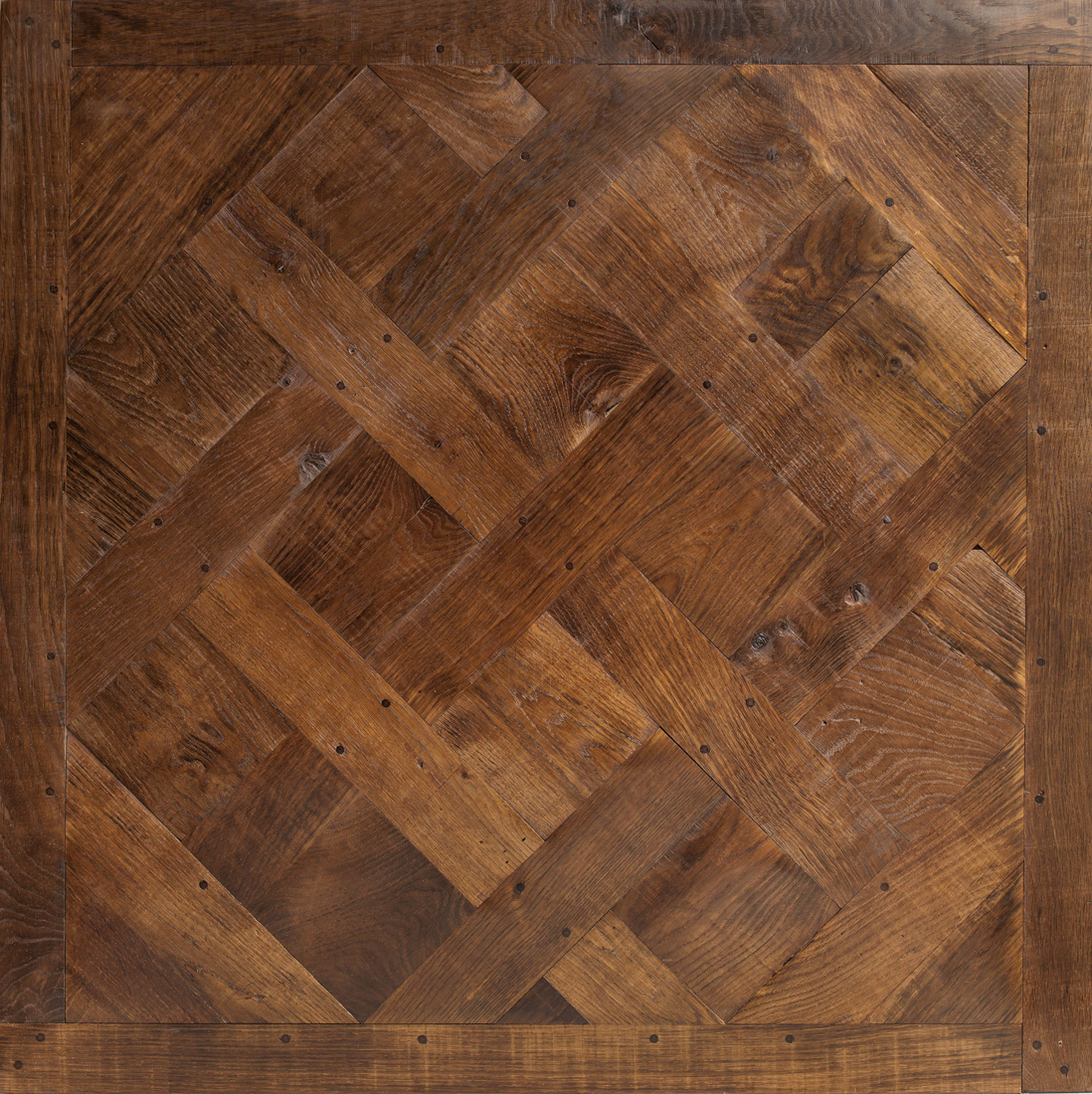
A master artisan highlights rather than hides these organic textures. Twisted whorls and ridges aren’t defects but maps exposing the indomitable spirit of overcoming tribulations. Bulging burls depict trees healing wounds into nutrients for new growth, while cracks speak of the tenacity to survive wildfires, droughts, and time.
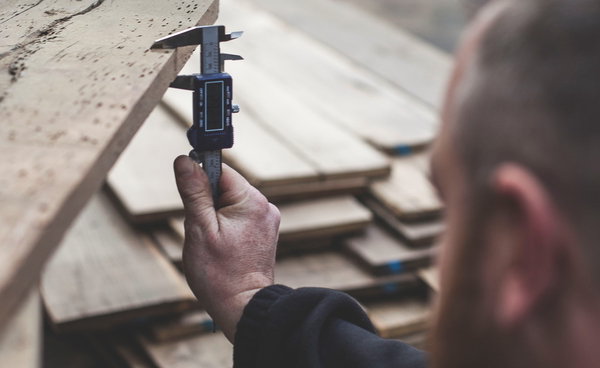
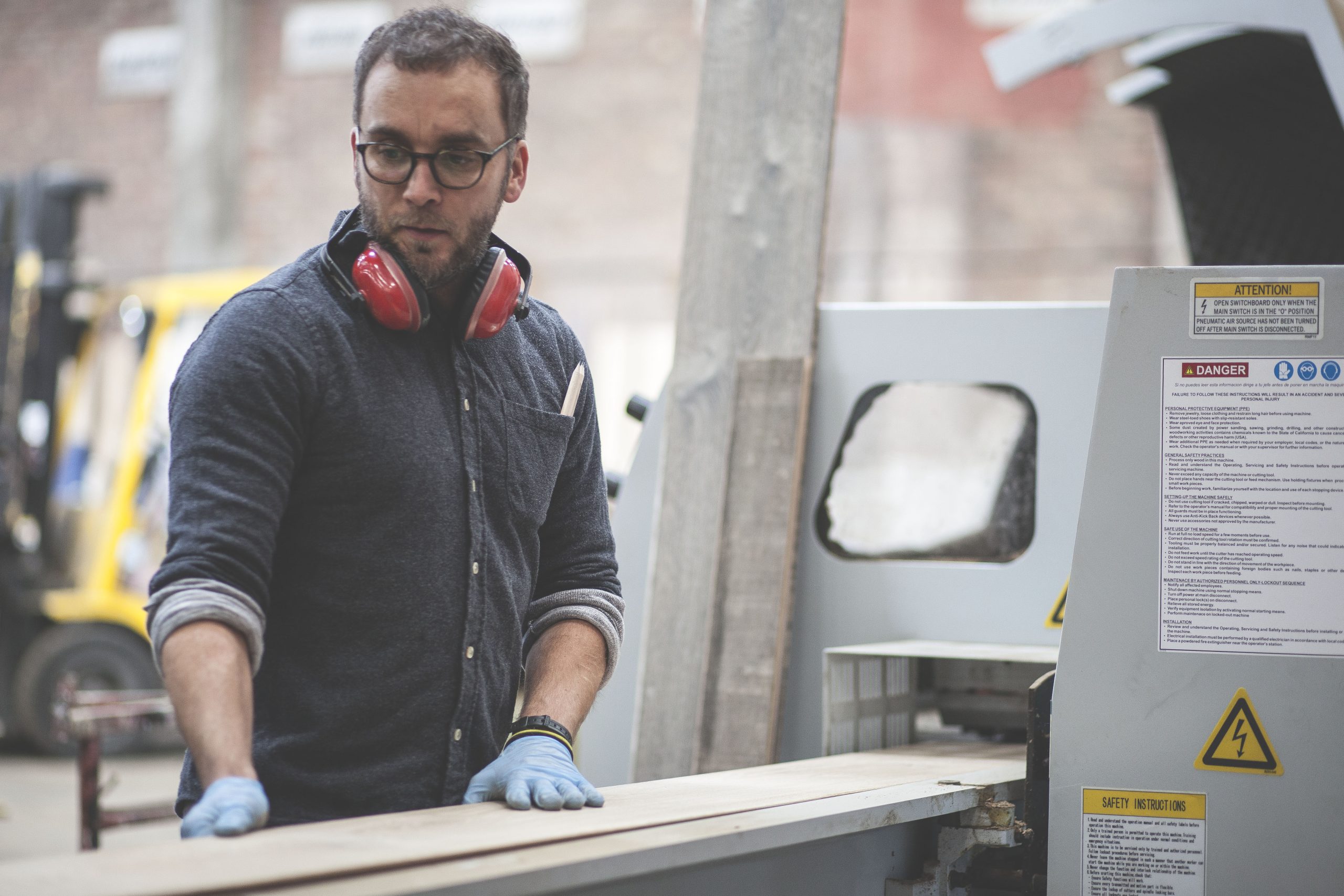
Tracing distinctive grains and gnarls reveals the spirit living within every plank and beam, shaped by wind, rain, and seasons.
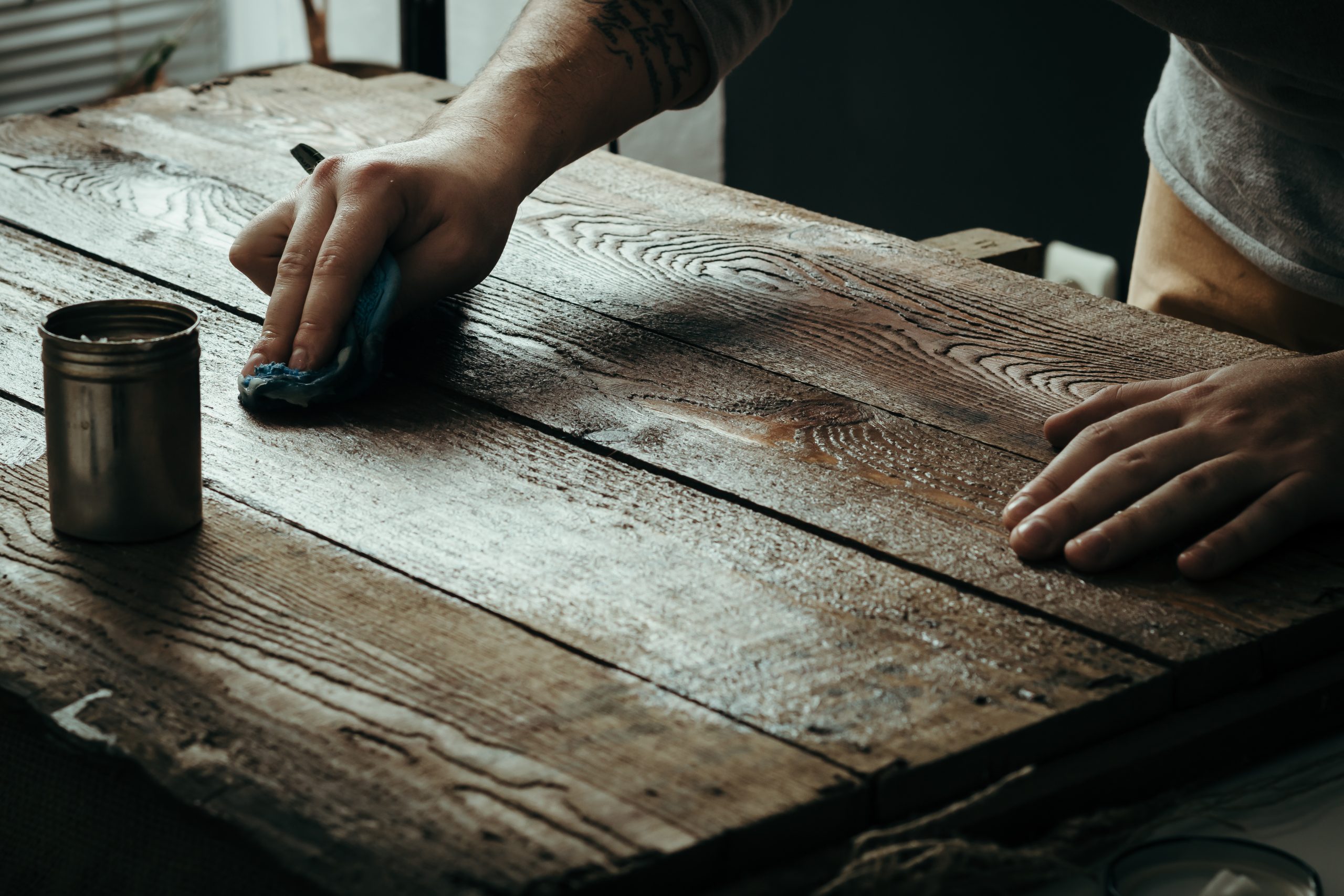
Using reclaimed wood for projects like hardwood flooring pays homage to Nakashima’s philosophy, honouring the material’s living stories.
With reclaimed wood, you aren’t dealing with fresh-cut, factory-finished floor planks. Instead, the wood tells a story through its naturally weathered texture and patina.

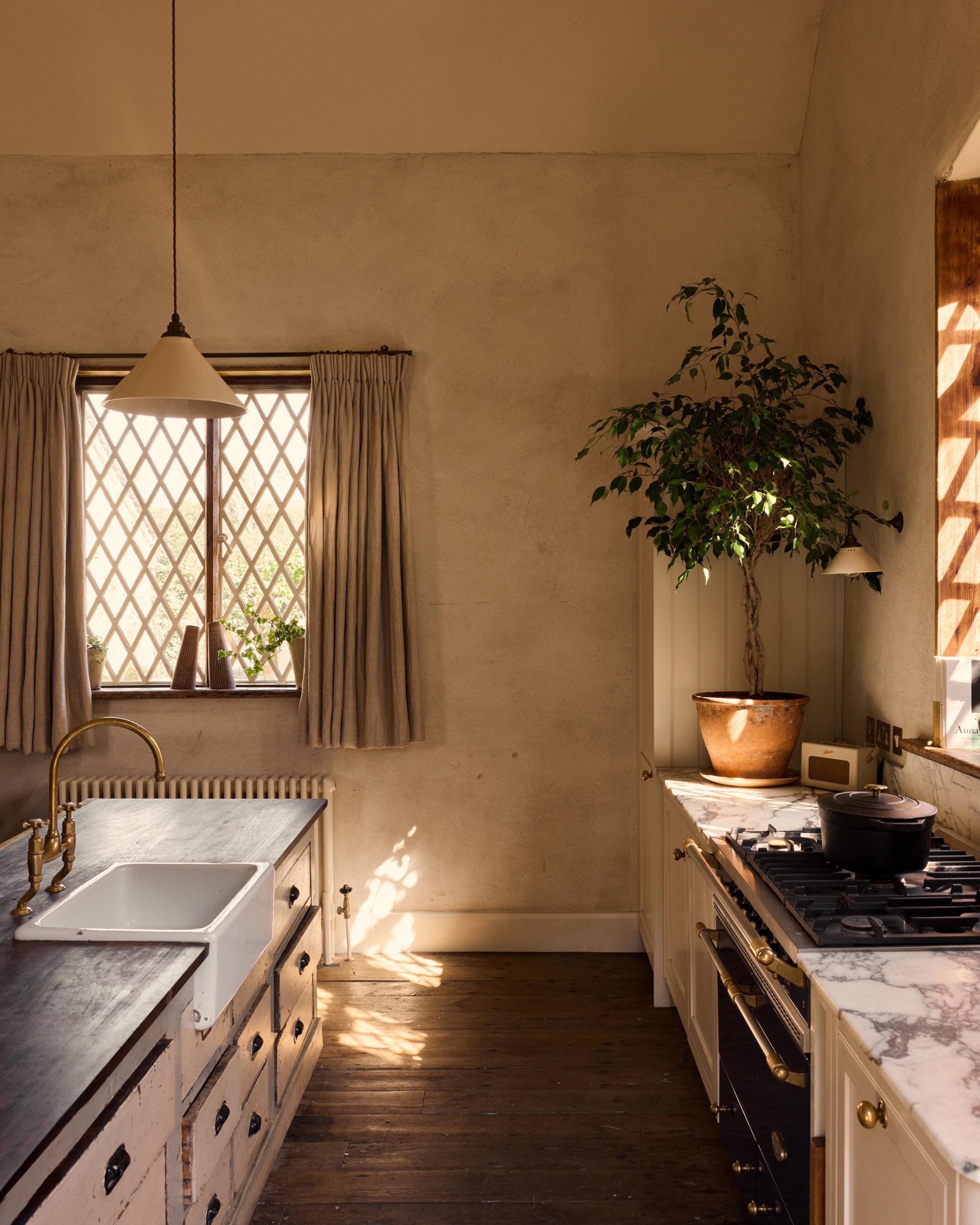
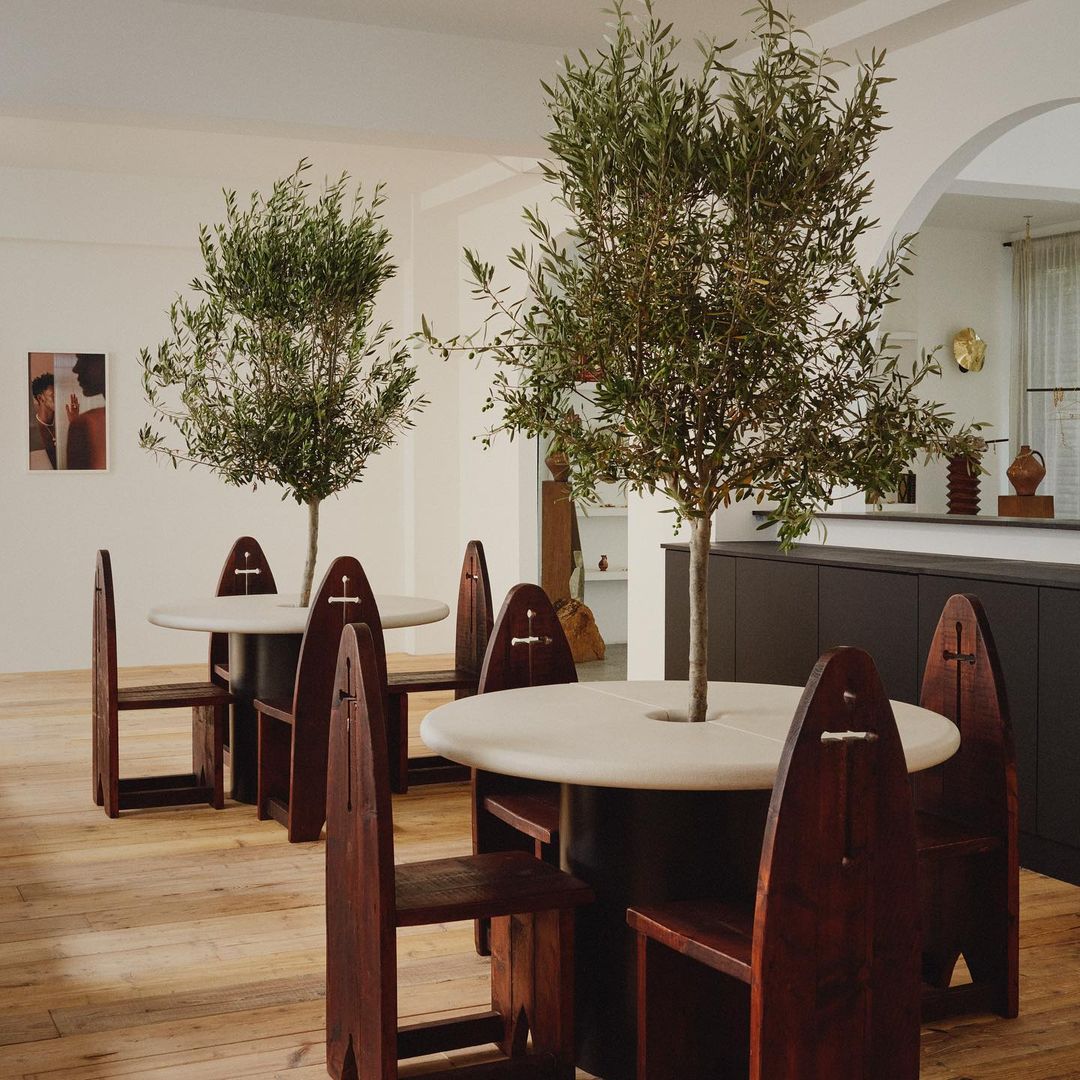
“There must be a union between the spirit in wood and the spirit in man. The grain of the wood must relate closely to its function… The tree lives on in its new form.” (George Nakashima, AZQuotes)
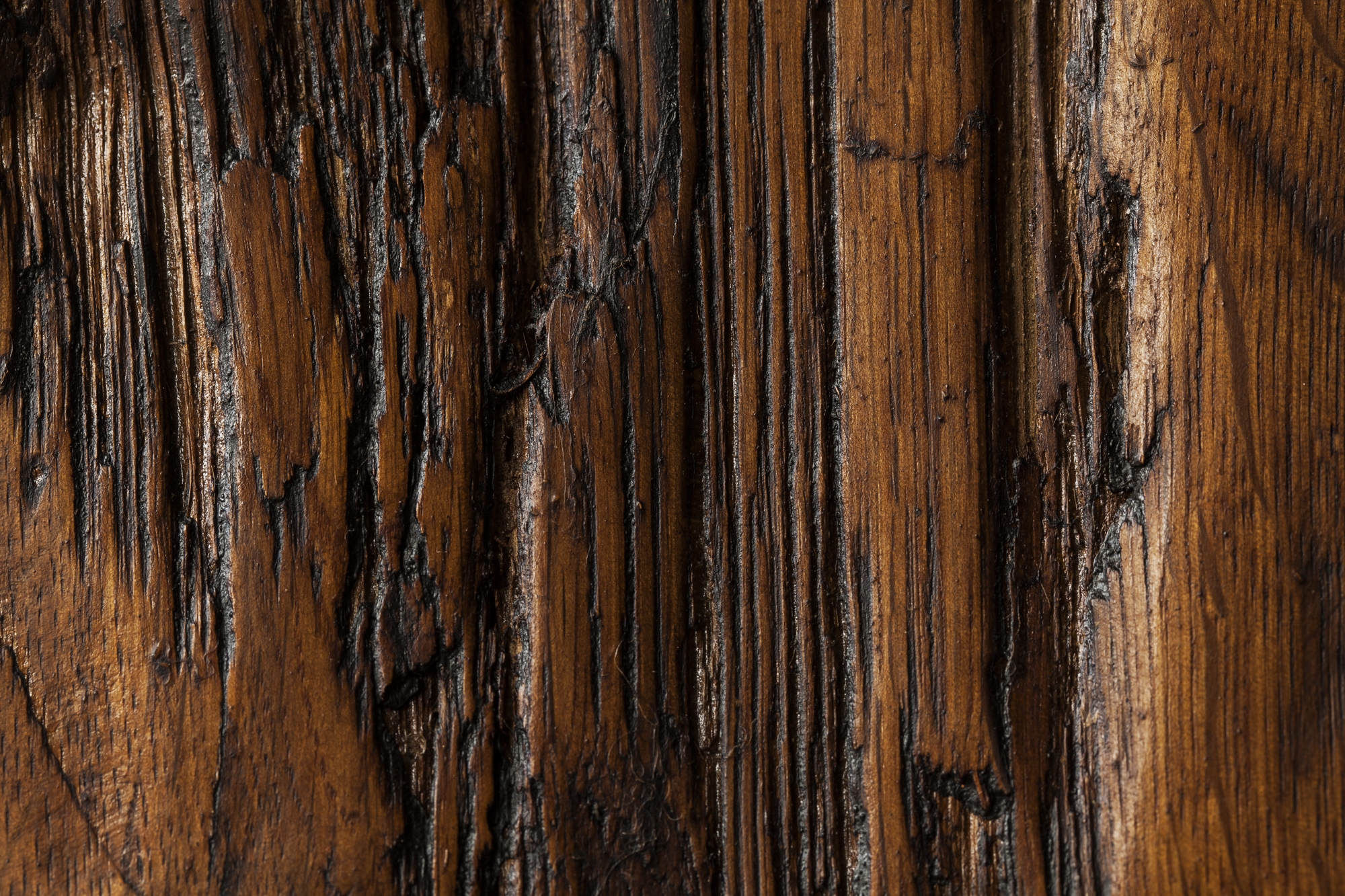
Appreciating wood is about recognizing the living spirit, the tale of perseverance and resilience cradled in every grain.
Whether you’re an artisan repurposing timbers or simply admiring a tree’s gnarly textures, if you truly observe and listen, there’s a resonance with that indomitable essence.
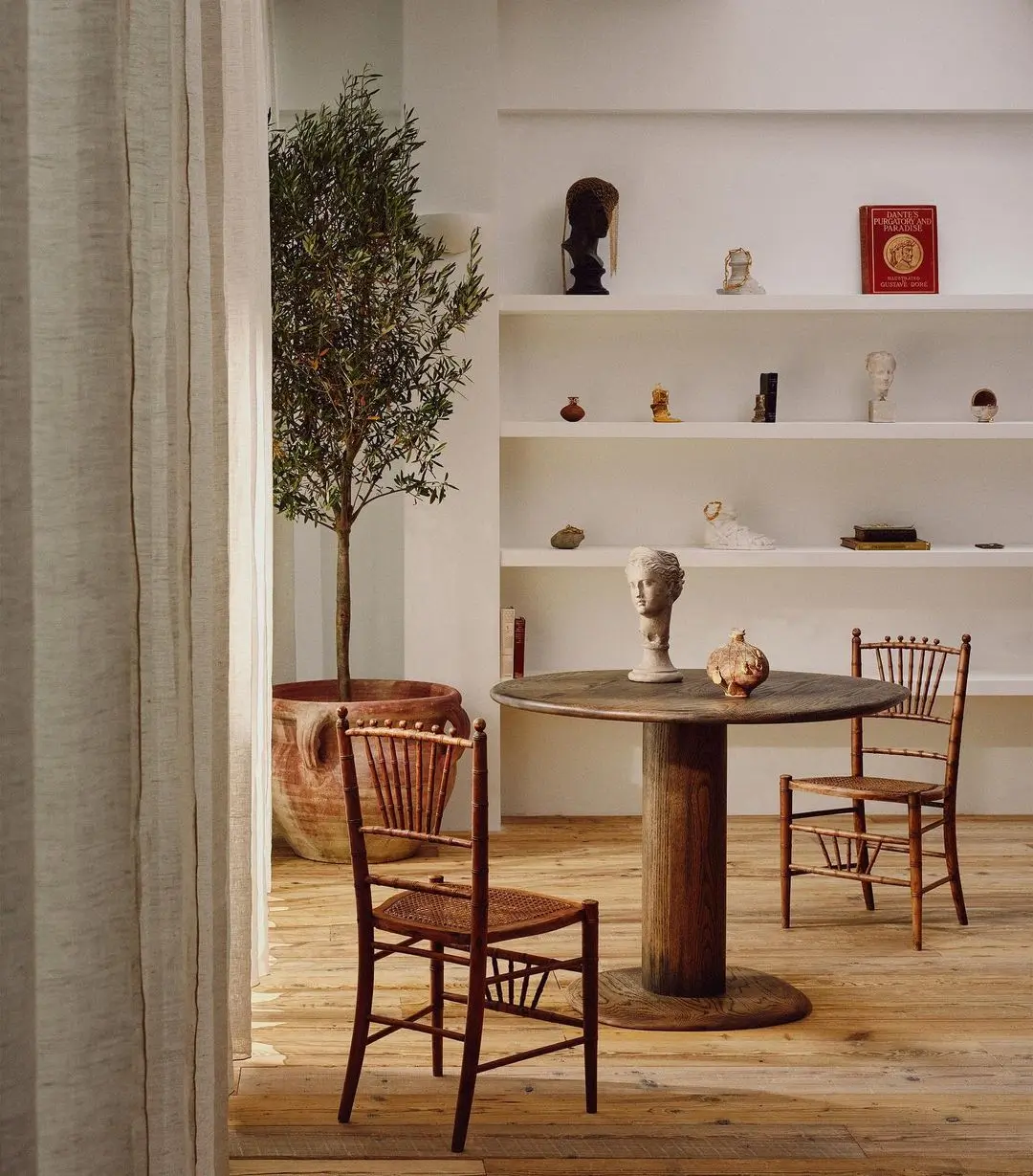
References:
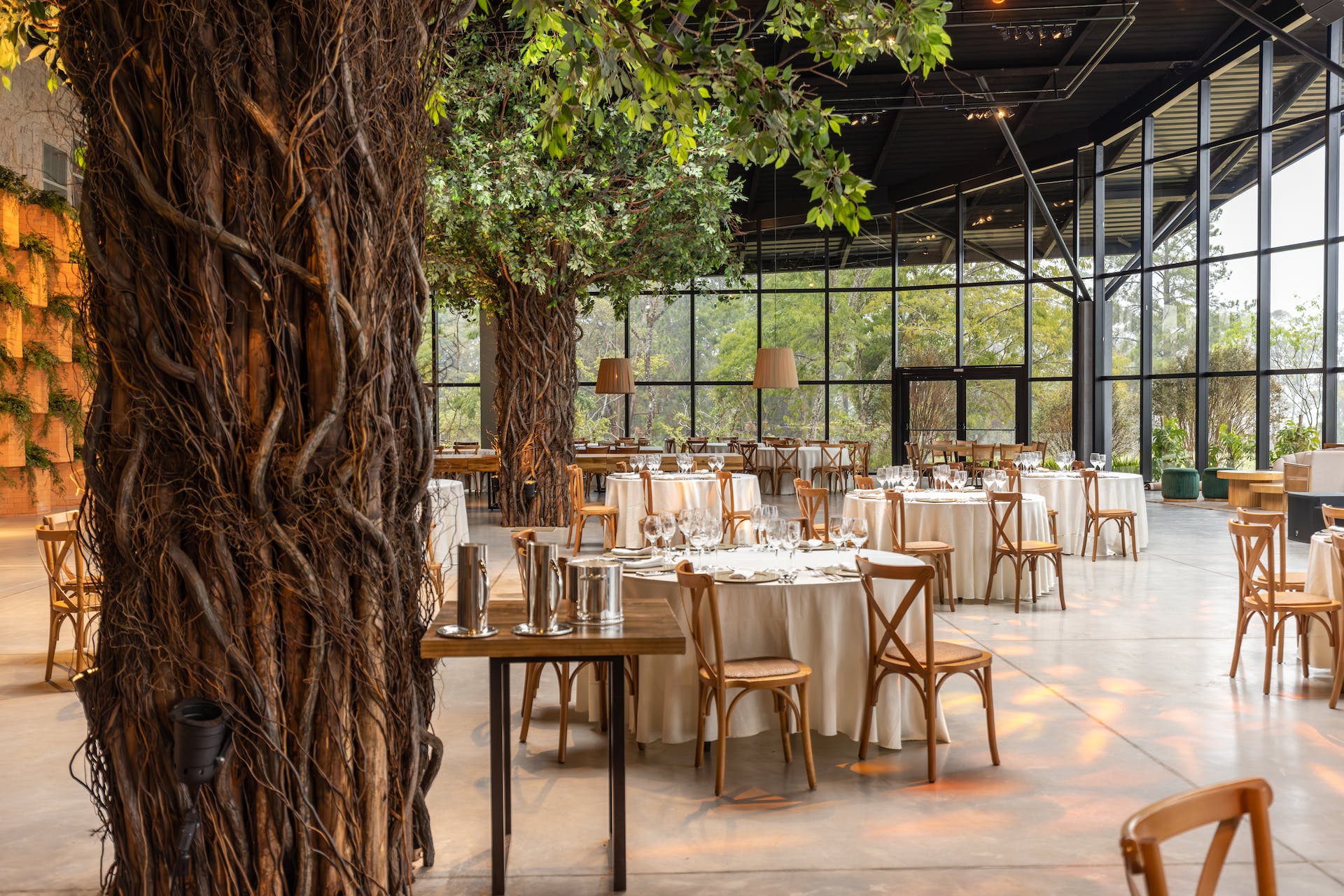
In the burgeoning landscape of interior design, the fervour with which we are reinventing our living and working environments in the UK—a market worth a staggering £1.5 billion in 2023—speaks volumes about our collective quest for spaces that nurture our souls and bodies. As we pivot to a new era, integrating more natural elements and sustainable materials is becoming imperative. For those yet to embrace the verdant hues of greenery, you’re potentially sidestepping the most transformative trend of 2024: the essence of biophilic design.



The visionary entomologist E.O. Wilson introduced the concept of biophilia in his seminal 1984 book, explaining our innate affinity for the natural world. Wilson argues, “We are in the fullest sense a biological species and will find little ultimate meaning apart from the remainder of life.” Our deep-rooted connection with nature transcends aesthetic appreciation—it’s a vital component of our essence, woven into the very fabric of our DNA.
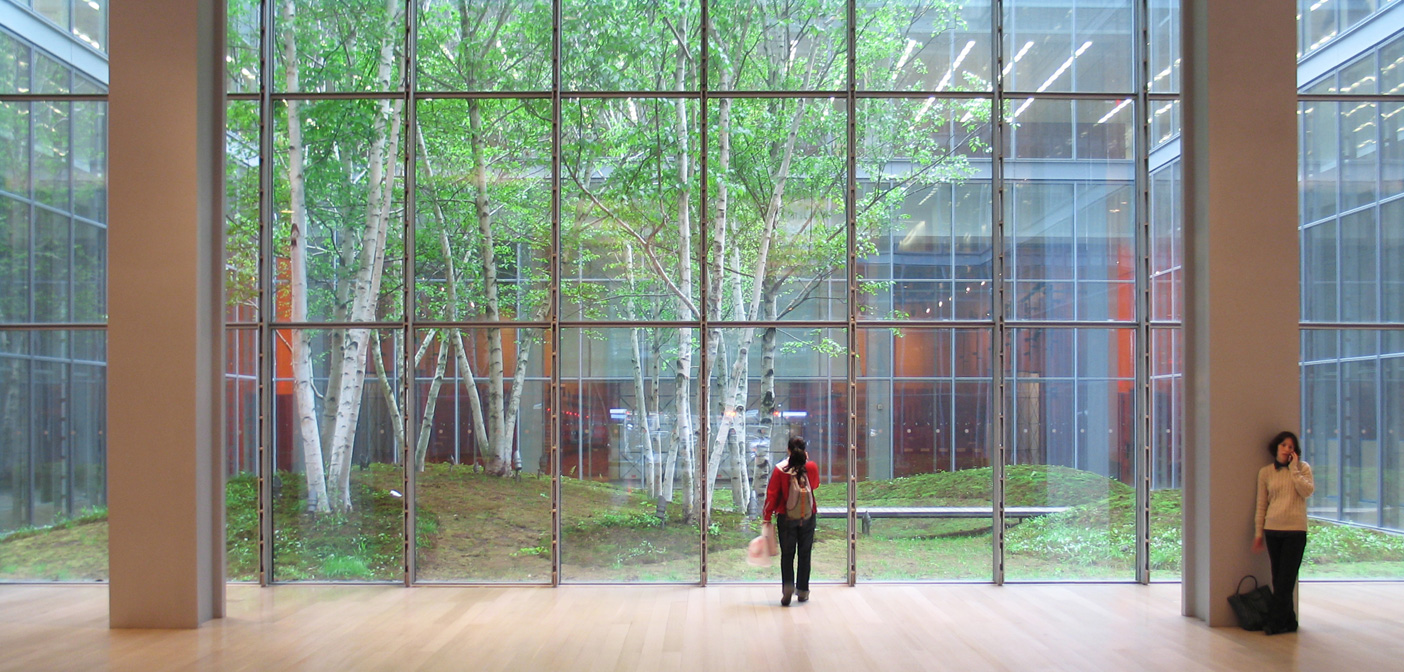
Historically, our ancestors thrived in symbiosis with their natural surroundings, deriving sustenance, shelter, and spiritual enrichment from the earth. Despite centuries of technological advancement and urban sprawl, our intrinsic need for natural connections must remain public. The interplay of light, colour, texture, and organic forms creates aesthetic harmony and is pivotal for our physical, mental, and emotional health. Many studies corroborate that proximity to natural elements significantly enhances happiness, health, and productivity across all demographics.

Our Aged Wood
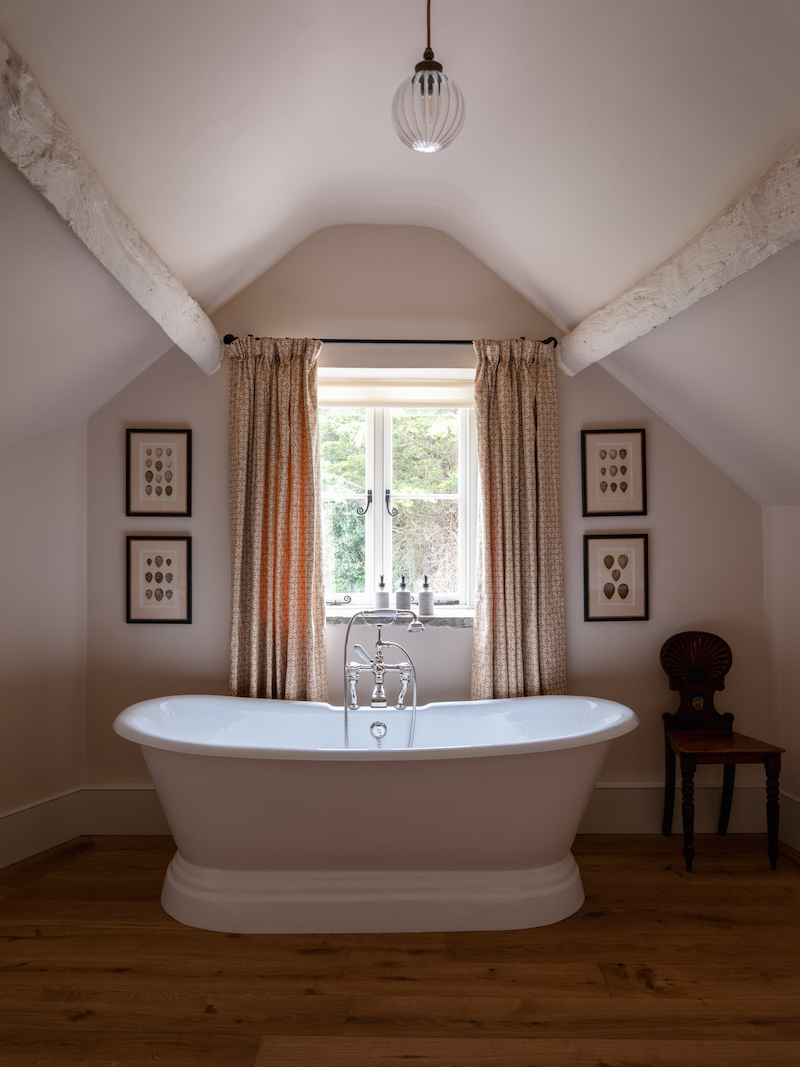
Our Aged Wood
Integrating natural elements—such as plants, wood, and sunlight—has proven to substantially increase productivity, creativity, and job satisfaction in the workplace. The Human Space Report highlights that employees in environments with natural features report a 15% higher overall well-being, 6% more productivity, and 15% greater creativity.
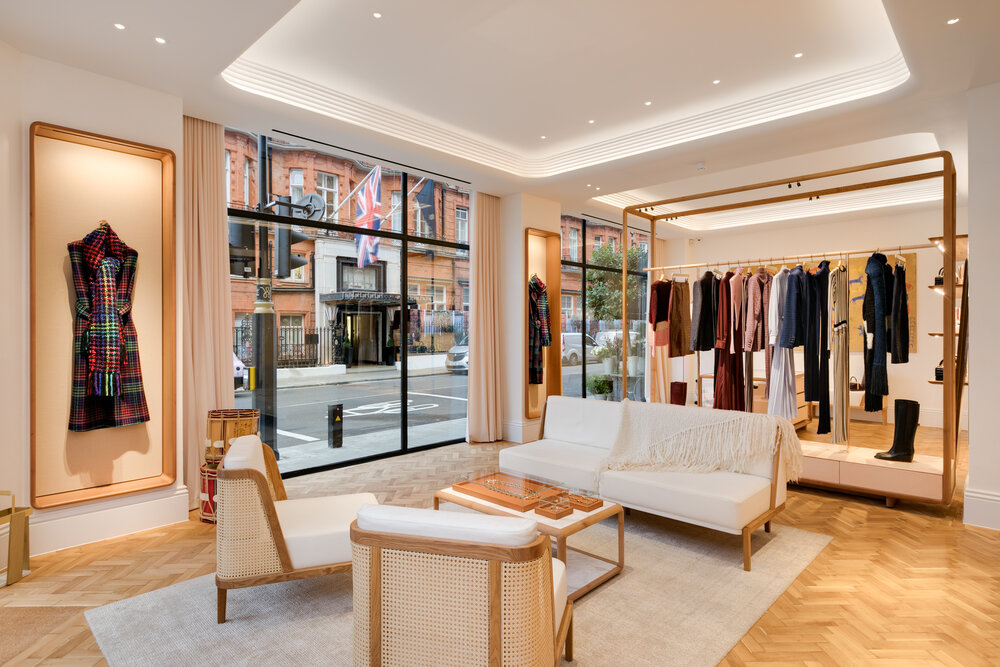
Our Reclaimed Wood
Biophilic design sets new paradigms for our living and working spaces as we gaze into the future. The Barbican Conservatory in London exemplifies this trend, with its lush tropical flora and warm-toned wooden accents creating a serene urban retreat. Similarly, the Limewood Hotel in Hampshire exemplifies biophilic principles, harmoniously blending luxurious accommodations with the rustic charm of the New Forest National Park.
Here are a few biophilic design trends that are gaining momentum:
Embrace Plant Life: Integrating plants into home interiors—from kitchens to bedrooms—is becoming increasingly popular. Plants not only enhance the aesthetic quality of a space but also have health benefits, such as reducing stress and improving mood. However, the choice of plants matters; varieties with soft, rounded leaves tend to be more soothing than those with sharp edges.
Incorporate Organic Shapes and Patterns: Curvilinear forms and fractal patterns, which mimic the undulating waves and rippling dunes, are staples in interior design. These elements introduce a dynamic, naturalistic flow into living spaces, promoting a sense of calm and connection with the natural world.
Maximize Natural Light: Exposure to natural light is crucial for maintaining psychological well-being. A study published in Natural Mental Health found that ample daylight exposure was linked to a 20% lower risk of depression. To enhance natural light, consider more oversized windows, skylights, or even glass walls that connect the indoors with the outdoors.
Engage the Senses: Biophilic design also encompasses auditory and olfactory experiences. Adding water features and using natural scents can transform a space into a multi-sensory haven, enriching the overall experience of the inhabitants.

“Naturally aged wood bolsters biophilic design, connecting indoor spaces with the natural world.” Andres Uprimny of The Reclaimed Flooring Company
Conclusion
Biophilic design transcends mere trendiness—a fundamental shift in how we conceive our personal and professional spaces. By integrating natural elements, we pay homage to our biophilic roots and enhance our well-being and productivity. As we continue to shape our environments, let the principles of biophilic design guide our choices, ensuring that we create spaces that are not only beautiful but also deeply connected to the natural world.

Travel is a gateway to the world’s wonders, a path to discovering new vistas.
Yet, in the age of regenerative exploration, travel transcends traditional boundaries. It becomes a transformative journey, unveiling the beauty of diverse landscapes and cultures while enriching and revitalising them.
Regenerative travel elevates the concept of sustainable tourism.
It goes beyond minimising our environmental footprint to actively rejuvenate the places and communities we visit.
This approach transforms travellers into agents of positive change, celebrating local traditions, engaging in conservation efforts, and making mindful choices that contribute to the well-being of our global village.
The ethos of regeneration is spreading its roots into the realms of design and architecture, inspiring the creation of spaces that not only exist in harmony with their surroundings but also contribute to their vitality.
Innovative designers are reimagining waste as resources, crafting materials that breathe new life into our environments and economies. This movement towards a circular economy champions using renewable resources and repurposing waste, paving the way for a future where every design decision fosters sustainability and resilience.
As Laurence Carr, a renowned regenerative designer, notes, embracing circular practices allows us to turn our environmental impact from negative to positive,” Given that the cost of raw materials makes up a big chunk of production expenses, using less desirable leftover materials from unavoidable processes can actually give manufacturers a significant upper hand,” said Carr. “In this way, circular principles are not just good for the environment and human health; they also benefit the economy at large. It’s a win-win-win!”
To truly revive our surroundings, we must rethink production and embrace the circular economy – prioritising renewable, non-toxic materials while reusing and recycling existing waste.
Impact Acoustic leads this charge, which crafts lightweight, structurally sound panels from cotton linters—a by-product of the cotton industry typically discarded as waste.
Utilising solar energy and closed-loop water recycling, their production process is nearly zero-waste.
“Our cotton acoustic tiles represent the epitome of circularity,” explains CEO Sven Erni. “The material can be reused repeatedly without extra resources whilst maintaining quality.”
Erni emphasises, “We firmly believe that embracing the circular economy is crucial for addressing challenges such as resource depletion, waste generation, and environmental degradation while fostering a more sustainable, prosperous, and resilient society.”
As we embark on this journey together, we all hold the power to make a difference.
Through small, intentional acts at home, advocating for sustainable practices, and embracing circular principles in every aspect of our lives, we can collectively forge a path to a regenerative future.
It is a future where design, travel, and daily living are intertwined in a symbiotic relationship with the earth. It creates a world where every step leaves a positive imprint, fostering hope and renewal for future generations.

2024 is poised to be a year of sustainability in interior design, driven by a growing awareness of the environmental impact of manufactured materials.
Consumers now more than ever recognize the need to prioritize natural materials and biophilic design, making sustainability a mainstream concern.
In the wake of allegations of greenwashing by major brands in 2023 and ongoing discoveries about the dangers of microplastics, the shift toward sustainable design is a natural response to safeguard our homes and the planet.
Sustainable interior design trends for 2024 will revolve around the origins, reusability, and eco-friendliness of the materials we incorporate into our living spaces.
These trends will also include the latest energy-saving and energy-efficient technologies, resulting in biophilic, technologically advanced environments that enhance our well-being and our families.
Creating sustainable homes hinges on materials’ durability and timeless design quality.
Thoughtful choices of robust, natural materials like reclaimed wood and stone offer longevity and adaptability, evolving gracefully with our changing needs.
When combined with timeless designs crafted by skilled artisans, our choices become an investment in both our homes and the planet, aligning with the ethos of sustainability.
The year 2024 will witness a shift towards kitchens constructed from sustainable materials, leaving behind the era of cheap, disposable alternatives.
The focus will be on materials that endure and represent genuine investments in our homes and the environment.
Consumers will actively seek out suppliers with green credentials, looking for certifications like FSC, LEED, and B Corp to ensure the sustainability of their choices.
Integrating technology into homes, historically not synonymous with sustainability, is evolving to align with eco-consciousness.
Tech companies are responding to consumer demands for sustainability, incorporating Wi-Fi technologies to future-proof home appliances.
Modern tech-enabled appliances are designed for energy efficiency and resource conservation, making them indispensable components of sustainable design in 2024.
Biophilic design, beneficial for both well-being and the planet, can transform our homes into havens of serenity.
Incorporating elements like plants, wood, and stone improves air quality and connects us to the natural world, promoting ecological harmony and personal tranquillity.
Customizing our living spaces to suit our specific needs, especially in kitchens and bathrooms, is critical to future-proofing our designs.
Multifunctional and adaptable spaces that can transition to meet evolving needs without replacing existing elements will be central to personalization in 2024.
Modular design and transformative layouts, crafted from sustainable materials and practices, will define this approach.
Colour trends in 2024 draw inspiration from nature, with warm hues reflecting natural tones, from winter sky creams to forest greens and earthy reds and oranges.
Nature-mimicking colours enhance the biophilic experience of our spaces, echoing their calming effects.
Selecting paints and wall coverings from manufacturers with ecological credentials, such as being plastic-free, low VOC, and B Corp certified remains essential.
In addition, PANTONE selected 13-1023 Peach Fuzz to become the colour of the year 2024.
An indicator that earthy palettes and colours that nurture the spirit, mind, body, and soul align with current wellness trends.
In 2024, consumers are acutely aware of the importance of protecting the environment and making thoughtful choices.
Prioritizing sustainable design is not just a trend; it’s a philosophy that helps us make conscientious decisions for our homes and the planet.
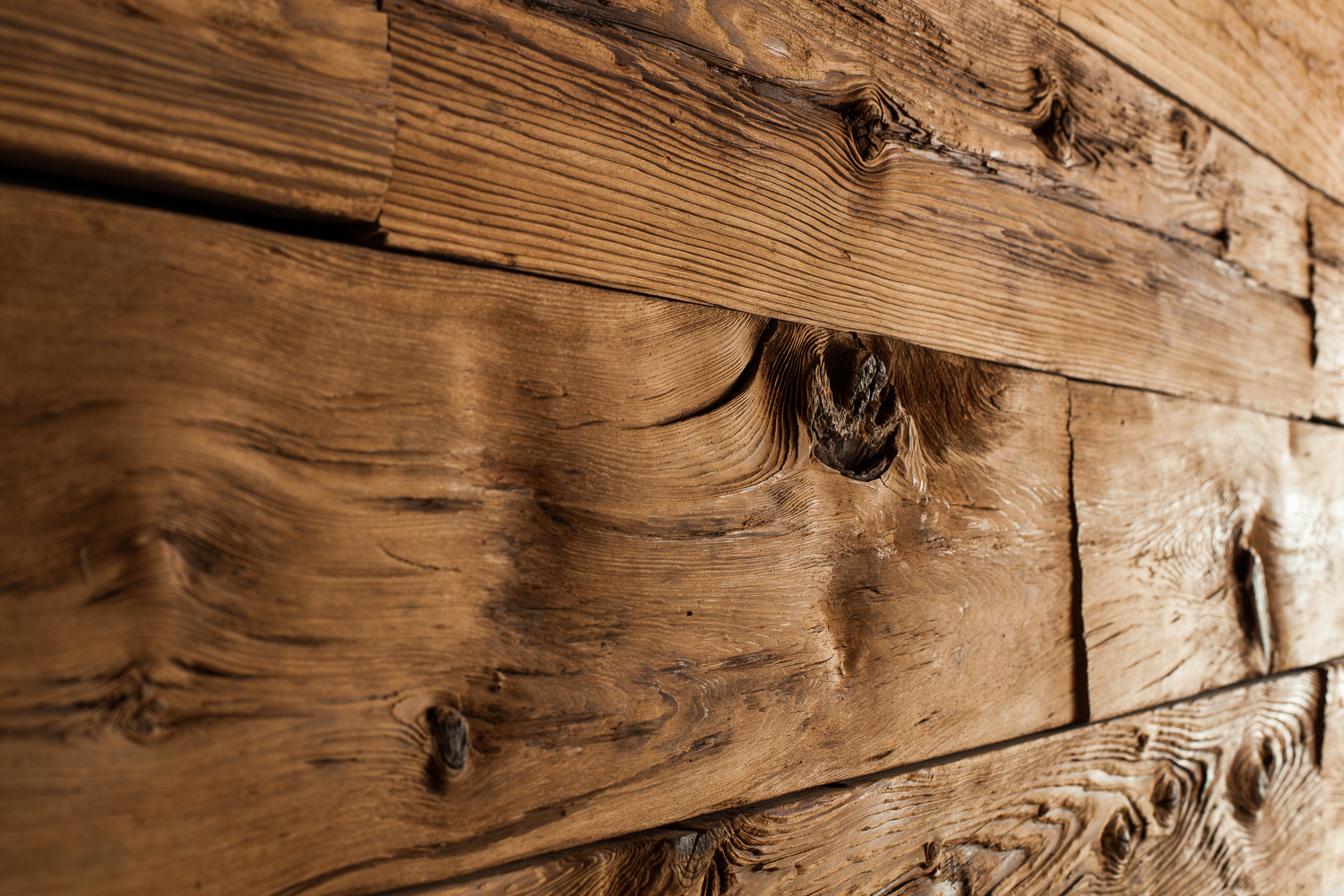
Reclaimed wood or lumber has a history and has been used for buildings and structures from the 18th to the early 20th century. The wood is recycled and reused to meet today’s ever-growing need for sustainable, eco-friendly homes and businesses.
Reclaimed wood shouldn´t be confused with salvaged wood, which has been cut and stored for several years but is not used for construction.
Today’s century-old reclaimed wood emerges from a time when wood was in abundance, both in North America and Europe, and was used as a primary building material.
As the Industrial Revolution took hold, sawmills were often the core of many towns, providing employment and a plentiful wood supply.
Most recycled flooring and wall panelling in homes, offices, bars, and restaurants come from the factories, warehouses, mills and railways of the USA and France and the industrial north of England.
In recent years, we’ve come to learn to protect our world, and there is less wood available for construction, so we’ve looked to the ecological equivalent of newly harvested wood – reclaimed wood.
Reclaimed wood is a stylish and popular choice to decorate and enhance commercial premises and modern homes.
Wood over 100 years old is particularly suitable for high-traffic areas due to its tight grain, making it resistant and hard-wearing.
Any wood species can be reclaimed, but some of the most common are Douglas fir, redwood, pine and oak.
A rare reclaimed wood species is longleaf (heart) pine, which can take up to 500 years to mature, as opposed to the more common yellow pine, which only takes 50 years.
Longleaf pine produced enormous trees in the past, meaning long and sturdy planks, which were the mainstay of the USA’s wood industry hundreds of years ago.
However, today, only 2% of its original planted area in the US is covered by this species, compared to 41% in the 1800s. This loss is immense and shows why using reclaimed wood is so important.
English oak trees are also rare and incredibly long-living, and they take up to 200 years to reach maturity. Making it arguably the longest-living tree you can find in the English landscape.
Oak is a popular choice for reclaimed wood and, in particular flooring due to its versatility in terms of finish and colouring. Much of our reclaimed oak flooring range comes from oak trees used for old buildings throughout Europe.
Besides the beautifully rustic character reclaimed wood lends to any building, modern or traditional, commercial or private, its ecological benefit is clear.
The environmental impact of mass forestation worldwide has heightened our awareness of how using reclaimed wood can help protect our future.
Coupled with this social responsibility is the desire for the authenticity of reclaimed wood that tells a story and has a history. Your kitchen floor could have once been the walls of a French railway station or your office wall cladding the beams from a barn or warehouse.
There are various reclaimed wood grades from different periods and backgrounds. It’s essential to consider the following when choosing reclaimed wood (which is what we do on your behalf):
When you buy your reclaimed wood from a specialist, you pay not to worry about potential defects. These are the most common problems with reclaimed timber that specialist suppliers look out for.
A reclaimed wooden floor or wall cladding makes a statement. As well as demonstrating excellent taste and a love for the character and finish of reclaimed wood, it shows your commitment to environmental matters.
Reclaimed wood is used for both residential and commercial projects alike. It can be used for interiors and exteriors as flooring, furniture or cladding.
The strongest feature of reclaimed wood is the tonal variation. We feel this should be embraced rather than combated. Depending on what you choose to finish the floor with (hard wax oil, traditional wax, lacquer), you will be able to even out the tone of the floor, but this will not be as uniform as pre-finished new wood.
You should ask your fitter about colouring options if you are concerned about achieving the right colour when using reclaimed wood.
Not all reclaimed wood is FSC certified; however, referring to their rules around reclaimed or recycled timber is helpful. For it to qualify as FSC-certified timber of post-consumer origin, reclaimed wood must have been used once and have reached “the end of its useful life” for its original purpose.
FSC-certified wood has met specific standards that guarantee sustainable practices were used in its creation. Using FSC-certified timbers in your building will earn you credits in the Leadership in Energy and Environmental Design (LEED) Green Building Rating System.
After carefully processing reclaimed wood into flooring, it is highly stable and can be installed like most solid and hardwood flooring.
The difference is that reclaimed wood can take two or three weeks to be ready for installation and acclimatise to the new environment and the humidity level.
Depending on the natural surface of the wood, some boards may require some hand scraping to even out a few of the edges.
Wood acclimation and installation are the two most important things to ensure your flooring lasts a lifetime.
Glue and Nails are the standards with Reclaimed Wood, but reading the supplier’s installation manual is always advisable.
* We do not recommend the floating methodology, as it is not a long-term solution.
Reclaimed wood floors are an excellent choice for kitchens and bathrooms.
Older reclaimed planks have naturally closed pores, which makes antique reclaimed wood great for kitchens and bathrooms.
However, sealing on-site is always advisable.
Like any new wood floor, reclaimed wood will perform and look its best with appropriate maintenance.
Wood finishing, indoor foot traffic, and usage level are the few things that will direct a care and maintenance program.
The proper care goes a long way and can help keep your floors great for decades.
For more information on after-care, use this link:
Not all reclaimed wood is Antique, and very few understand the difference. Most of our antique wood is at least 300 to 400 years old, and just like with a centuries-old Antique cabinet, a limited material supply is available.
Unlike other reclaimed collections that are easier to procure, they are cut from old structural beams.
As with any skilled Antique restoration, working with antique wood requires many skills for the thousand judgment calls one must consider when uncovering such timeless beauty piece by piece.
Because wood is a natural organic material, the Leadership in Energy and Environmental Design (LEED) considers solid wood an inherently non-emitting source for Volatile Organic Compounds (VOCs).
This means that it doesn’t give off any pollution; more than this, wood can absorb toxins from our environment.
These low VOCs can be affected by products added to the wood, like a finish, fire retardant, substrates or glue.
It is worth checking your supplier’s environmental credentials to ensure they do all they can to keep VOCs to a minimum.
Reclaimed wood can be expensive because of the work of reclaiming and refinishing it.
There are costs associated with the transportation, storage and artisanal skills involved in creating reclaimed wood products, which affect the price and value of the product.
Reclaimed flooring costs between two and three times as much as conventional flooring. But this varies hugely depending on many variables.
The price of reclaimed wood products can be affected by lots of factors, including:
Prices also vary between companies. Generally, you will spend a little more than you would on new wood because of the extra work and skill involved in salvaging wood, treating it and restoring its beauty.
One of the beauties of reclaimed wood is patterns, lines, and markings tell its unique story. This story doesn’t end when this wood is brought into a home; it just starts a new chapter.
Reclaimed wood can continue to change colour or weather, depending on the wood used, the chosen treatments, and how regularly the wood is maintained.
The LEED program is a well-recognised rating system for sustainable building. Architects and designers can increase their chances of a whole project qualifying for LEED certification by using reclaimed wood products in their projects.
The WELL Building Standard measures and certifies features of the built environment that impact human health and well-being. It is well-documented that bringing wood into our homes and office spaces suits our physical and mental well-being.
Living Building Challenge (LBC) is a comprehensive sustainable building standard designed to encourage building practices that enhance community life and benefit the planet.
LEED, WELL and LBC were all created to work harmoniously with each other, and reclaimed wood products show how well they do this.
With LEED rewarding the sustainability of reusing precious materials, WELL recognising the well-being-boosting properties of wood and LBD rewarding the community and planetary impact, they help to illustrate how valuable a reclaimed wood product is.
As both WELL Building Standard and Living Building Challenge (LBC) have biophilic design focuses, the certification helps illustrate how reclaimed wood is an impactful and logical solution for bringing nature into a space.
It has now been proven that it also can enhance our wellness. Maybe this is why it’s so tempting to stroke a smooth wooden bannister or to feel the finish on a bespoke piece of joinery.
With the growth of biophilic design, architects and designers are increasingly considering wellness.
Low VOC materials are being chosen over their more highly manufactured and polluting counterparts, and elements that enhance daylight’s impact and allow for proper ventilation are considered essential, especially in our post-pandemic world.
Biophilia explains our connection to nature and opposes the industrial minimalism that has become the norm in our built environments over the preceding decades. As the hard lines and artificial lighting that minimalism promoted are not found in nature, we now understand why they adversely affect everything from communication to mental health to productivity.
The studies in Japan revealed that wood serves as a de-stressor and has been shown to lower blood pressure, while Canadian studies yielded similar results: wood contributed to lower heart rates and stress responses than environments with no wood.
While these results focus on wood in general, we have seen anecdotally that Reclaimed wood can deliver emotional connection and, therefore, a more significant biophilic effect. Because reclaimed wood has a history and a story, its history enhances the occupant’s experience in the space in an authentic and meaningful manner, making them not just feel better but be better.
With just over 2200 Certified B Corporations globally, B-certified products are still hard to come by.
While reclaimed wood’s eco credentials make it an ideal candidate for B Corp certification, there aren’t currently any Reclaimed wood suppliers listed among the 2200 B Corp-certified companies.
This could be because B Corp certification measures far more than just the regenerative nature of a business. It also weighs a company’s inclusivity and equitability to measure its social and environmental impact.
There are, however, several architecture, design and building companies recognised with B Corp certification, including:
Seeing so many companies associated with the traditionally damaging construction industry being recognised with this certification is a sign that the industry is moving in the right direction.
Absolutely, reclaimed wood can be crafted into all kinds of joinery, from simple items like kitchen countertops, shelves, and doors to intricate pieces such as staircases and furniture.
However, not every type of wood may suit your project, so it’s crucial to discuss with our team to understand the extent of customization possible.
At The Reclaimed Flooring Company, we believe in the tree’s soul; we feel that this phrase perfectly represents our brand values, such as Slow Design & Slow Living, Timelessness, Generosity, Reciprocity, Sustainability, Humility, and Community.
We promise to ethically beautify, inspire, craft, make and install with the tree’s soul in mind.
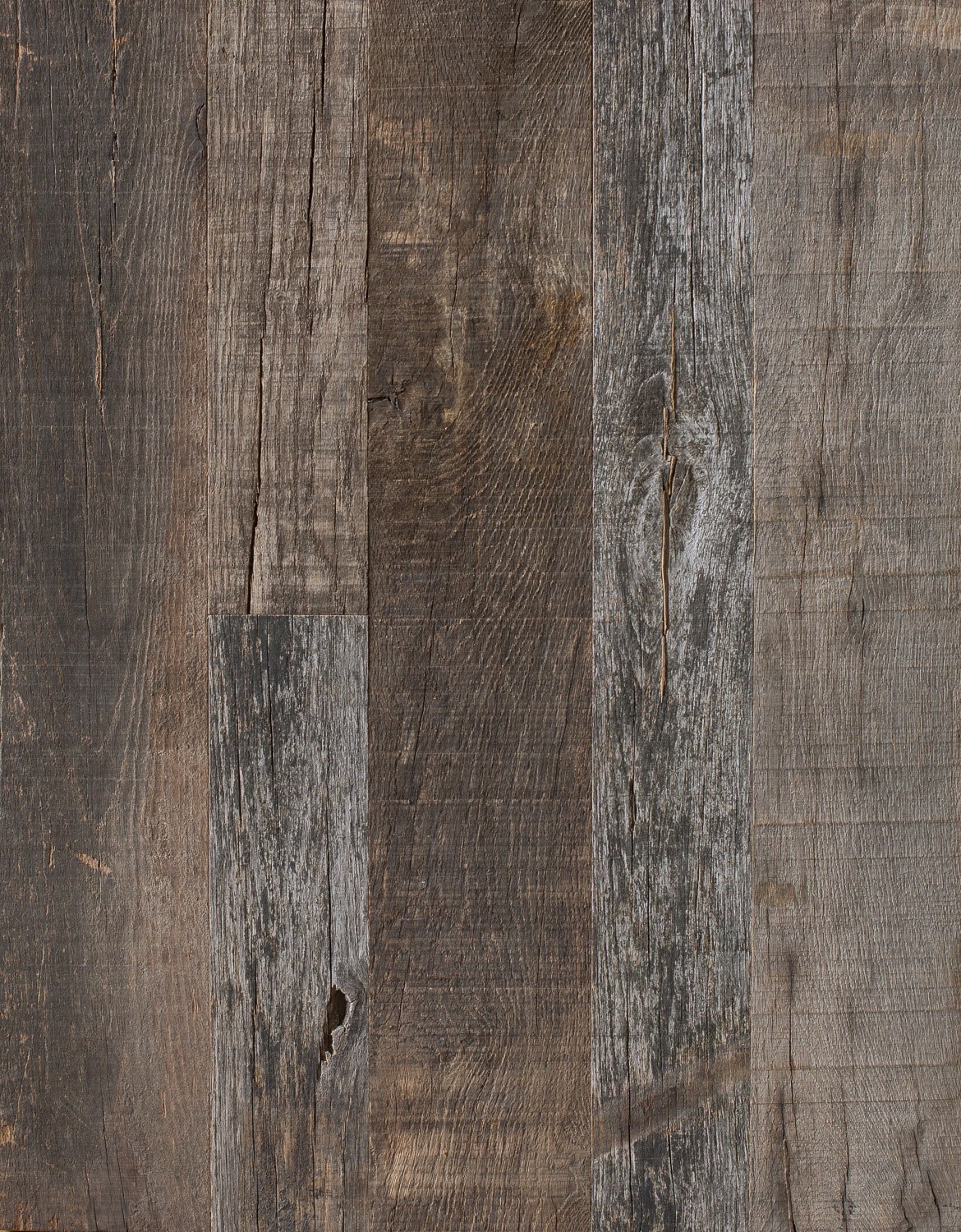
Oiled finish wood flooring has become an increasingly popular choice for most homeowners and builders.
Mainly because of the aesthetics of the pleasing natural and warm look and the fact that the oil finish helps make the real character of the wood stand out without any “plastic” shine.
A hardwearing option – when maintained correctly, it looks beautiful and adds a touch of sophistication to any room.
Treatment with wood oil is perfect for anyone who is seeking to retain and enhance the natural good looks and brings out the same beautiful look that many exotic wood species have.
The oiled finish option suits both reclaimed and harvested wooden floors, both solid and engineered options, no matter where you plan to install your new floors.
If an oiled finish is your choice of wood flooring, it’s crucial to keep the coating of your flooring in proper condition by oiling it regularly and minimizing the risk of scratches, scrapes and chips.
To help protect the coating on your floor, a thorough and regular cleaning regime is required to keep the floor free of dirt and dust.
Dust and grit are the worst on oil-coated wood floors as they act as an abrasive, serving to remove the oil coating and leave your wood flooring exposed.
How frequently the floor requires cleaning will ultimately determine the regularity of the re-oiling or oil-refreshing process required.
For peace of mind, we suggest applying a hard-wax maintenance oil every 6-10 months.
A well-oiled wood floor normally requires a regular vacuum and a thorough going over with a moist, not wet, mop to keep it looking amazing.
Ideally, the vacuum attachment should be a natural bristle brush or a type that will not scratch the floor.
When the hardwood floor needs more than just vacuum cleaning – that is, re-sanding and re-finishing; how often you require such drastic treatment depends upon the traffic, wear and tear and maintenance regime your floor has experienced.
If the oiled wood floor is looking really tired and in need of a complete revamp, here’s what you need to do:
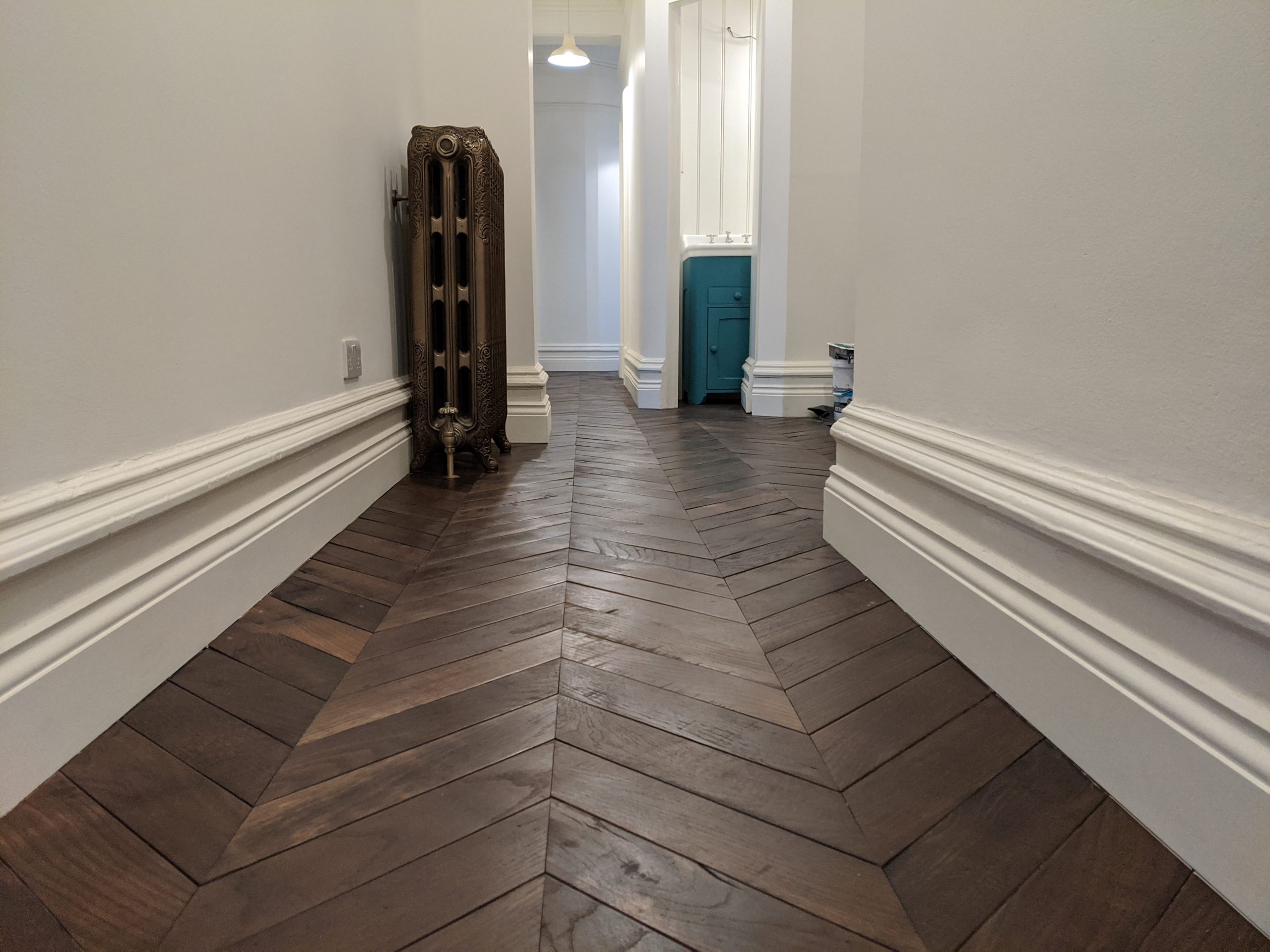
As more and more people re-evaluate their impact on the planet, environmental awareness and conscious consumption have increasingly been on the rise.
The use of natural material is at the top of the agenda — with designers, professionals, and homeowners embracing “greener” lifestyles and finding brilliant ways to incorporate organic textures whilst maintaining a more current aesthetic.
Besides being good for the environment, natural materials are durable, improve the microclimate of indoor spaces, and look stylish regardless of interior design and changing styles.
For many, this means not just using sustainably sourced products, but ones that last for decades without being shipped to the landfill.
Reclaimed timber, also known as salvaged, re-worked or antique wood, is the epitome of the world of natural materials and for obvious reasons. Not only is it the most renewable and sustainable resource you could possibly choose, but it evokes a profound sense of nature, has therapeutic properties, and ages beautifully, developing a wonderful patina over time.
Reclaimed wood flooring, reclaimed wood cladding, reclaimed wood siding, reclaimed wood beams, reclaimed wood stairs, reclaimed wood furniture — it’s everywhere… and it represents impactful stories of repurposing and making use of what would have otherwise been abandoned and wasted.
The use of reclaimed timber to finish and decorate both residential and commercial buildings isn’t a new concept, but it’s seen a surge in popularity especially with the green building and remodelling boom.
Reclaimed flooring (often oak, chestnut or pine) is simply “upcycled” wood finish with a past life used for a new purpose.
Perhaps it was a storage crate, wine barrel, retired ship or a part of a building, typically an old barn, factory, warehouse, and it is of good enough quality to be milled and fashioned into new antique floorboards.
For many, the true beauty of reclaimed timber is in its rich history as well as distinctive charm, beauty and narrative. Used in and around the home, the flooring provides whispers and echoes of the past and looks beautifully aged yet timeless. It is these character qualities that make reclaimed floorboards popular throughout the UK.
The use of sophisticated, warm wood textures lends a rustic look that almost seamlessly connects your living space to the natural world. For some, it’s more than the aesthetics — it’s the conservation element that makes reclaimed wood their number one choice for their next interior project. Still others, it’s its durability and strength that captures their attention and makes reclaimed floorboards a meaningful design component.
Unlike virgin floors from freshly cut trees, milling reclaimed floorboards have far less impact on the environment.
Traditional methods involved in the creation of floorboards can be a depleting process requiring enormous amounts of energy output for harvesting and an energy-intensive milling process.
The process of designing reclaimed floorboards bypasses this environmental harm. Many of the steps required to prepare the salvaged wood to relieve pressure on our forests and uses 13 times less cumulative energy. Having already survived through decades or even centuries growing in clean, pollution-free air and soil, the wood has also matured within the projects it has graced and taken on the glow of many years of exposure to the elements too.
This makes reclaimed wood flooring even more sustainable, as no extra trees need to be felled to create a beautiful wood floor with a look and feel that cannot be duplicated. After saving the wood from the demolished site, manufacturers set about reworking the old wood planks into exceptional reclaimed flooring, removing the nails and bolts, cleaning and finishing the wood, mostly by hand, and dried in a kiln to sterilise and ensure it is dried down to the proper moisture content intended for interior application.
Here it undergoes a plethora of delicate restorative and transformative techniques to obtain a good top and a good bottom. A lot of skill and creativity gives the wood a new lease on life, making the manufactured floorboards ready for yet more decades of experience in the heart of a newly built project.
Throughout the process of extending the service life of old timber into new floorboards, the wood retains carbon, keeping potentially harmful gas locked out of the atmosphere. This alone, makes reclaimed wood sit in a very strong position of what a truly, naturally sustainable product is all about.
Being recycled between key stages of its lifecycle and lasting for generations whilst ageing gracefully within the built environment makes reclaimed floorboards instrumental to the circular economy model. These environmentally friendly credentials also mean newly reclaimed floors can last another 100 years — meaning low energy and waste manufacturing as well as an overall happier and healthier planet.
The use of reclaimed timber offers a wealth of natural beauty and eco-friendly benefits. Some of the main advantages include:
Appearance
It is the timber prior history that enriches and enhances the natural beauty of reclaimed floorboards. Each plank embodies a distinctive characteristic while benefiting from the patina of old age growth. Reclaimed wood flooring creates a deeper experience and adds instant authenticity and personality wherever it is laid.
What’s more, its exceptionally tight grain, unique knots and swirls, rugged texture, organically weathered colour and patina adds a touch of “traditional allure and depth” to an interior environment, especially when paired with more modern furniture and objects.
Strong and durable
Aside from its aesthetic qualities, floorboards constructed from reclaimed timber are incredibly strong, dimensionally stable, and physically durable with better rot resistance than most newly harvested woods — being up to 40 points harder on the Janka hardness scale.
When old residences, warehouses and factories were built in and around the UK between the 18th-20th century, only the most stable and durable lumber cut from trees that grew for hundreds and even thousands of years were used so they could stand the test of time. The process of undergoing years of natural tempering and weathering means the matured wood has reached a point of being completely dried out and less prone to splitting or splintering.
Additionally, it is this great structural sturdiness that makes reclaimed floorboards a desirable option for high-traffic areas as it is able to better handle the wear and tear of everyday life while looking good for many years to come.
Environmentally friendly
As previously mentioned, reclaimed timber prevents the need for further depleting our natural forests by cutting down trees.
Knowing you’re using floorboards that would otherwise be unnecessarily burnt or enter landfills is an environmentally responsible choice that effectively contributes to the reduction of carbon footprint. Furthermore, wood that has already been harvested and treated restricts the need for refining chemicals which have a devastating impact on the environment.
The scale of environmental degradation is disheartening, in Europe as in the rest of the world. Our planet continues to suffer a great deal from the paradigm in which goods are bought, owned and disposed of.
As consumers become acutely aware of sustainable practices and corporate responsibility, the demand for products and services with lower environmental impact has gained momentum — and, in fact, consumers often demand — companies do better. The timber flooring industry has felt pressure to adapt to new ways of thinking about sustainable manufacturing by finding that elusive balance between people, profit and the planet.
Today, a growing number of companies are seeking out innovative ways of reutilising salvaged wood as well as new ways to make operations less harmful to the environment. More importantly, businesses are placing sustainability as an essential component of their corporate social responsibility plans and business strategies.
In implementing “Cradle to Cradle” solutions to improve their carbon footprint and providing safe and sustainable flooring options for a variety of needs, there has been a significant change in relation to environmental conservation. Ahead, we take a look at some of the leading businesses specialising in reclaimed floorboards in the UK.
1. The Reclaimed Flooring Company
The Reclaimed Flooring Company is proud to be the leading provider of the finest quality custom-milled floors for residential and commercial properties across the United Kingdom. We have spearheaded the quest for timeless, character-filled old wood with lasting value and are now market leaders in this specialist industry.
Part of Reclaimed Flooring Company core values includes bringing life back to this magnificent, unique material and turning it into something truly beautiful that carries a unique legacy. In a sense, our in-house team of highly skilled craftsmen integrate specialist finishing techniques and colouring processes to accentuate the unique qualities and innate beauty of reclaimed floorboards.
Whether it is reclaiming large beams from 17th-century barns, historical monuments, colonial homes or simply reclaimed old oak wine barrels, each antique board is hand-worked by highly-skilled craftsman to create a beautiful time-worn look and feel that will illuminate and bring character to any property.
Our work demonstrates the dedication to social, economic, and environmental responsibility. We recognise that forest certification preserves our nation’s past, and furthers its present goals for sustainability. All our flooring products are in compliance with VOC test requirements and qualify for LEED points under the materials and resources category, guaranteed to last.
Email: [email protected]
2. Authentic Reclamation LTD
Bringing reclaimed building material to the whole of the South East including Surrey and South London, Authentic Reclamation has been sourcing and supplying reclaimed building materials to the building, landscaping and private sectors for more than 30 years. Based on the Kent and Sussex border, the timber company houses an extensive stock of authentic reclaimed materials to bring design dreams and visions to life.
www.authentic-reclamation.co.uk
3. London Reclaimed Flooring
Located within 15 miles from Central London just on the outskirts of North London, London Reclaimed Flooring specialises in lifting and collecting all types of salvaged timber from a wide range of period properties, as well as supplying environmentally responsible timber products ideal for creating truly one-of-a-kind interior aesthetics.
With projects ranging from small home developments and conservation to retail stores and restaurants, this leading company in the Architectural Salvage & Reclamation business believes that antique floorboards not only accentuate the look and feel of your home or architectural project but are an essential link to ecological and environmental advances.
www.londonreclaimedflooring.co.uk
4. Encore Reclamation
After years of using contacts in a demolition business to source substantive and sustainable old pine and oak flooring for friends and family, husband and wife duo setup Encore Reclamation in the hopes to serve a wider range of designers, homeowners and professional businesses across the UK.
Located in the heart of London’s East End in a former Spratts dog biscuit factory, the company makes sourcing reclaimed building materials a fast, fun and financially viable process. If you’re on the lookout for character-rich reclaimed floorboards to give even a new build old soul, Encore Reclamation takes special pride in supplying premium quality products for any interior design and architectural project.
www.encorereclamation.co.uk
5. LASSCO
Established in London’s East End, LASSCO has dealt in reclamation since 1979. Bridging the gap between the demolition trade and architectural design, the company connect customers with rescued relics that make for fascinating interiors. Since its inception in the late 1970s, the company continues to be one of the UK’s leading providers of custom reclaimed floors with a showroom and design specialists in London’s East End.
www.lassco.co.uk
6. Salvo
By choosing only the finest reclaimed antique wood, Salvo is the marketplace for architectural antiques, garden, decorative, salvage and reclaimed building materials that bring out the inherent richness of nature.
Following the principle of “Reclaim, Reuse, Repeat”, Salvo helps designers and homeowners alike create buildings that will impress and last by providing demolition alerts, a worldwide directory of salvage-related businesses, as well as online platform where they can buy from trusted Salvo Code dealers.
www.salvoweb.com/antique-reclaimed
7. English Salvage
English Salvage works passionately to bring a historic era to retail and restaurant spaces, film set constructions, and residential projects. Quality and craftsmanship come first, and every process starts with sourcing the highest-quality timber and continues with precise milling that enhances the distinctive charm of each and every board — ensuring that you receive the most beautiful outcome for your architectural project.
www.englishsalvage.co.uk
8. Lawson’s Yard
Established over 70 years ago by Thomas Lawson senior, Lawson’s Yard is passionate about re-purposing material, reusing waste and minimising resources. Combining time-honoured techniques with modern machining, the Ormskirk-based company transforms salvaged and pre-loved lumber to consistently produce the finest quality reclaimed flooring, cladding, doors and furniture — ensuring that each final product is unique to each project and in keeping with a scheme’s design, ethos and heritage.
www.lawsonsyard.co.uk
9. The Main Company
Passionate about bringing you the highest quality, The Main Company has an outstanding reputation for crafting high quality reclaimed flooring ideal for both commercial and residential spaces. Nestled in the heart of Yorkshire, the company specialises in engineering reclaimed & rustic wood flooring.
A combination of knowledge, unrivalled passion and craftsmanship ensure that they deliver floors that have a story to tell and are meticulously handcrafted and restored to bring out the stunning patinas and rustic features that suit every space.
www.maincompany.com
10. The British Wood Flooring Company
The British Wood Flooring Company is one of the UK’s largest reclamation companies with a large stock of original, authentic and bespoke salvaged, reclaimed and upcycled timber including; antique wood flooring, Parquet block, Parquet de Versailles and bespoke solid wood floors for residential properties and mixed-use commercial projects.
With knowledge and exceptional experience in installing, refurbishing and finishing wood floors, The British Wood Flooring Company works closely with clients at every stage of the design process to complement their individual needs. From London townhouses to country cottages, new-builds and period properties — each board is created with alchemy to give a stunning and unique finish to every interior design environment.
www.britishwoodflooring.co.uk
Conclusion
Procured from retired ships, old barns, homes and commercial buildings of all kinds, reclaimed lumber wins points for sustainability.
With its everyday practicality, each one of the floorboards has its own character, offering a true one-of-a-kind design finish for both old and modern settings.
Reclaimed floorboards in the UK have transformed a wide array of interior design and architectural projects — from London Victorian townhouses and period properties to modern farmhouses and new-builds — and the fact that no new trees have to be harvested to design the flooring makes them one of the most sought-after salvaged building materials.
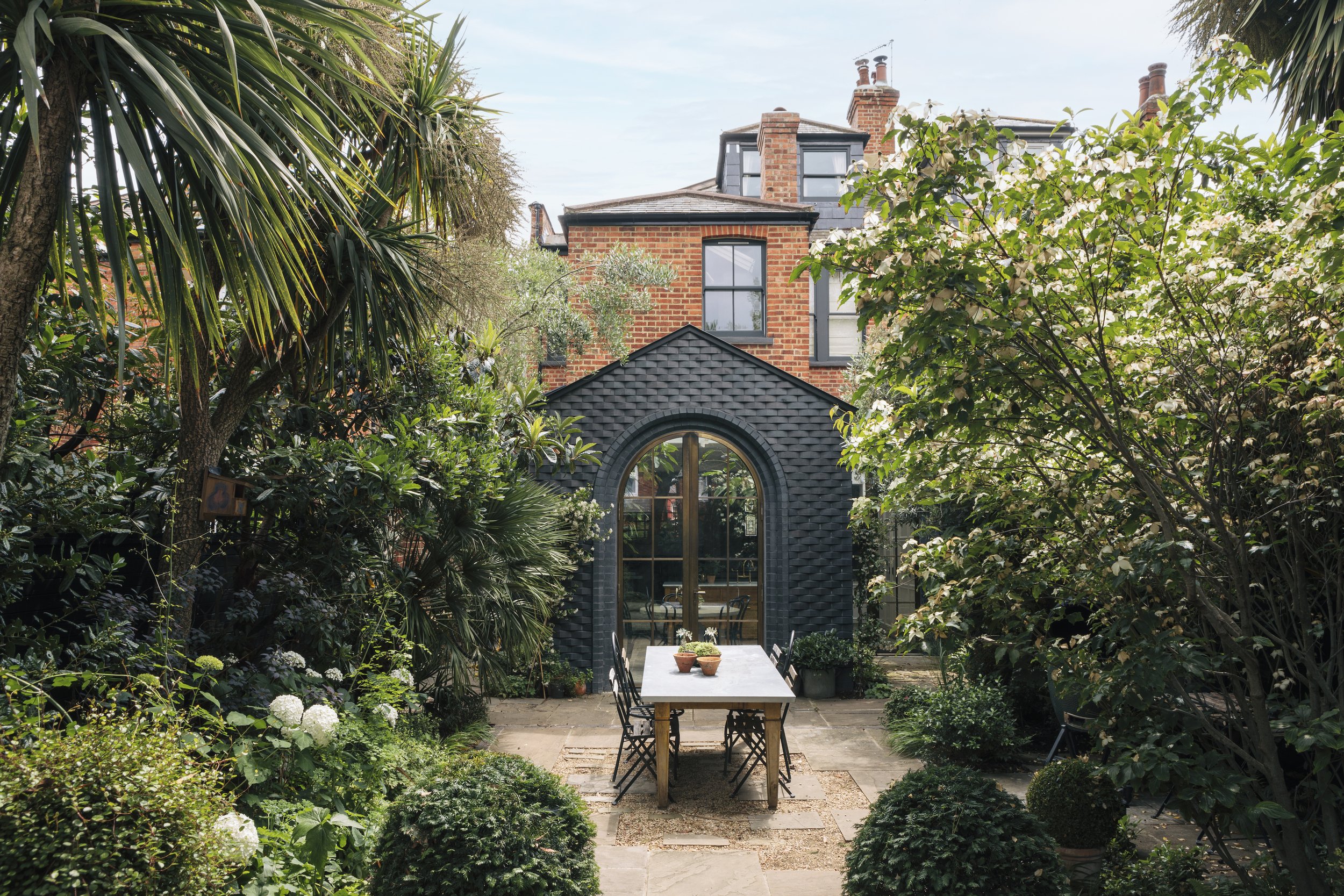
In her groundbreaking work, “Thrive,” Arianna Huffington introduces the concept of the Third Metric, urging us to redefine success beyond the conventional markers of wealth and power.
Centred on well-being, wisdom, wonder, and giving, Huffington’s approach challenges societal norms and reshapes our perspective on leading a fulfilled life.
As we delve into Huffington’s thought-provoking insights, we embark on a transformative journey toward a more deliberate, mindful, and purposeful existence.
Huffington raises concern over the conventional measures of success, emphasizing that “To live the lives we truly want and deserve, we need a Third Metric.”
Her call for a paradigm shift prompts us to move away from the relentless pursuit of traditional markers of achievement and focus on holistic pillars that enrich our lives. Echoing the thoughts of various intellectuals, Huffington’s book converges on the essence of practising intentional, mindful, and measured craftsmanship in our daily lives.
Transitioning to a thriving life, as Huffington indicates, is a practice demanding commitment and mindfulness. She notes, “Moving from struggle to grace requires practice and commitment,” highlighting the conscious effort needed for this transformation.
This shift invites us to cultivate mindfulness, self-reflection, and purposeful practices, paving the way for a more harmonious life rooted in well-being, wisdom, wonder, and giving.
Huffington repeatedly underscores the significance of eulogies and the legacy we leave behind. “Our eulogies are always about the other stuff: what we gave, how we connected,” emphasizing the importance of intangible qualities over societal markers of success. This juxtaposition prompts us to centre our lives on aspects that bring depth and meaning, aligning our daily actions with our values.
Huffington emphasises that our daily choices and actions author the narrative of our existence. “We’re actually writing it all the time, every day,” she notes, underlining the significance of aligning our actions with our deeper values. Embracing the Third Metric allows us to weave a narrative that celebrates well-being, wisdom, wonder, and giving, shaping a legacy of purpose and authenticity.
Advocating for a balanced approach, Huffington highlights the importance of integrating both heart and mind. “When they work together, the heart leading through empathy, the mind guiding us with focus and attention,” she points out. This harmony fosters reduced stress and cultivates a centred, fulfilling life by synergising empathy and focus in our daily pursuits.
Highlighting the impact of sleep on our well-being, Huffington emphasises, “Sleep deprivation reduces our emotional intelligence.” Acknowledging the critical role of sleep in various aspects of our lives, she advocates for prioritising rest to enhance emotional intelligence and nurture healthier relationships.
Encouraging a shift in perspective, Huffington invites us to rediscover wonder in our daily experiences. “Sometimes we must look through a different set of eyes,” she suggests, advocating for a renewed curiosity to find awe-inspiring moments in the ordinary.
Recognising stress management as vital, Huffington recommends integrating brief recovery rituals throughout the day. “Every few hours, take sixty seconds of recovery time,” she suggests, emphasising the importance of these moments in reducing stress and nurturing overall well-being.
Arianna Huffington’s “Thrive” challenges us to reconsider the definition of success through the Third Metric. We embark on a transformative journey towards a more fulfilling life by prioritising well-being, wisdom, wonder, and giving. Moving beyond struggle requires commitment, offering immeasurable rewards—a life centred on genuine connections, kindness, and purpose. Let’s author a daily narrative aligned with the eulogy we aspire to have—one that celebrates the profound impact of well-lived moments and a legacy focused on the Third Metric.